
CREATIVE EXPLORATION
AT YOUR OWN PACE
TAP INTO YOUR INNER WISDOM
Welcome to our self-directed art therapy class! Twice a month, we invite you to embark on a journey of self-discovery and healing through creative expression in the comfort of your own home. Each session will introduce you to a new theme accompanied by insightful teachings, an engaging creative activity, and thought-provoking prompts designed to promote introspection and reflection. The beauty of this class lies in its flexibility – you have the freedom to engage at your own pace, in your own time. There are no constraints here; take as little or as much time as you need to explore the depths of your emotions and experiences.
COMING SOON
The Art of Authenticity
If this week's self-directed activity doesn’t resonate with you, feel free to explore these 75 Art Therapy activities created by therapist Emily Sharp.
These activities are organized by creative medium, but if you’d like to explore a specific theme, you’ll find a categorized list on pages 21–24.
Note
The Art of Letting Go
Letting go is easier said than done; however, once you accomplish it, you can free yourself from the burden of holding onto what hurts you. Whether you're finally free from that bad relationship that haunts you, free from the image you once had of your life that looks different from reality, free from societal expectations, or a childhood that is difficult to remember but you can’t seem to forget. Overall, there is freedom from resentment and pain that comes with letting go.
You probably want personal freedom and to let go to free yourself, but you don’t know how to begin the process. You don’t know how to let life be the way it is in this moment, let go of a future that hasn’t occurred yet, and make peace with the past that didn’t go how you wanted it to. We want tranquility, and we know letting go is one avenue to get there, yet we tightly grip the ideas, dreams, grievances, and pain that keep us from the peace we desire. Why do we do that? Why can’t we just let go and move on?
First and foremost, letting go is a process that takes time. For example, to let go so you can forgive someone means making a conscious effort to release something hurtful that happened to you by no longer holding onto negative thought patterns, anger, resentment, or pain. By engaging in this process, you are making an active choice to no longer suffer from something you never had control over. When we see letting go this way, it becomes clear that it is also freedom. It is freedom from past and future victimization because when you let go of painful events, they no longer define or control your present.
Why Letting Go Is So Hard
You’re not a bad person if you’re finding it difficult to let go or even to forgive someone who hurt you; you’re human. As humans, we’re pre-programmed to avoid danger or anyone who has proven untrustworthy. We are programmed to remember negative experiences so that we can prevent them. Therefore, forgiving someone who harmed us or letting go of a bad experience goes against our instincts. More often than not, it is wise to listen to your instincts. But if they’re keeping you trapped in a place that doesn’t allow you to escape your suffering, it’s time to decide to let go.
As the influential teacher Ajahn Chah explained in his book Food for the Heart, when we choose not to follow the path of letting go, it is like deciding to carry a heavy rock around with us, weighing ourselves down. We don’t know what to do with the rock, so we keep carrying it around. Even if others explain the benefit of throwing away the rock, we’re still afraid to let it go. We’ve been carrying it for so long that it’s become a part of us, and we continue to carry it until we get so weak and tired that we have no choice but to let it go. Only then can we finally feel at peace and recognize how physically and mentally heavy that burden was. Letting go of negative feelings and pain invites peace and the release of unresolved emotional turmoil.
When deciding to let go, working on developing self-awareness is essential. When we develop self-awareness, we are more mindful of ourselves, who we are, and how we react to life’s challenges and the people in our lives. To be more self-aware is a gift of being more conscious, intentional, and wise. We can more readily note how we feel and then make a mindful decision on how to respond. When we aren’t self-aware, we float through life, reacting to situations in unhelpful ways. We end up with a life by default, not a life we choose. We wind up feeling stuck in our circumstances and helpless to make changes, making it especially difficult to let go and feel personal freedom. We often place all the blame on others and have a hard time releasing what hurt us and taking accountability for our lives.
Misconceptions About Letting Go
There is a misconception that letting go means that whatever happened is done and removed from our lives. Letting go doesn’t mean it didn’t happen or allows the person who hurt you off the hook; it certainly did happen, and that person is accountable. We are aware, accepting, and conscious of what happened. We deeply understand the facts and effects of what took place, though it no longer stings like it used to. Instead of wishing it didn’t happen, we don’t fight against it; we acknowledge its presence and let it be how it unfolded.
It helps to remember that we grow the most when we are challenged. Life’s obstacles show us who we are and how capable we are of standing on our own two feet. When we see our challenges as opportunities for growth rather than as stressful or painful constraints that hold us back, we reframe the situations that happened to us. Many people who have been hurt in excruciating ways learn how resilient they are through those events. They find meaning in giving back and helping those who have been through similar experiences. When we find meaning, purpose, and growth in our misfortunes, we can reframe the situation and refresh the narrative of how it will affect us, allowing us to let go and move forward.
We don’t have control over what happens to us, as much as we may try, though we do control how we choose to deal with those events. When deciding to let go, we focus on changing what we can control, our perspective. We feel hopeless and powerless when we focus on changing what we can’t. By shifting that focus, we regain power and release ourselves from an emotional prison.
From: Deciding to Let Go
Articles
Videos
The Unstoppable Power of Letting Go | Jill Sherer Murray (12 minutes)
Letting Go Gently With Love (13 minutes)
Dr. Wayne Dyer's Life Advice Moving Forward & Letting Go (14 minutes)
Continue Your Learning
Activity 1 - Holding the Past, Embracing the Future
Art Supplies
Mixed media paper (preferably large enough to trace both hands)
Pencil and eraser
Permanent marker (e.g., Sharpie)
Crayons, coloured pencils, markers, watercolours, or paints
Creative Activities
Directions
Hands are incredibly important in expressive therapy because they serve as both tools of creation and powerful symbols of personal experience. Through our hands, we express emotions, tell stories, and connect with our external world. They hold memories, represent our ability to give and receive, and symbolize the actions we take in life. From a mental health perspective, focusing on our hands through a symbolic lens is helpful to enhancing our self-awareness, as it allows us a chance to reflect on our strengths, emotions, capabilities, values, and goals in a grounded way.
Step 1: Tracing Your Hands
Begin by placing one hand flat on the paper. If you’re right-handed, start with your left hand (and vice versa). Use a pencil to trace around your hand, taking care to capture the unique shape of your fingers and palm. If tracing your non-dominant hand is difficult, ask for help or trace both hands with the pencil. Let the outlines of your hands overlap slightly on the paper.
Step 2: Outlining with Marker
Once you have traced both hands with a pencil, use a permanent marker to go over the outlines. This step helps make the hands stand out and ensures that the lines won’t smear when you paint. Don’t worry about perfection; embrace the imperfections as part of the process. Erase any excess pencil lines afterward.
Step 3: Left Hand - Exploring the Past
Focus on the left hand, which symbolizes the past. Reflect on what your hands used to hold—memories, emotions, roles, or habits. Write down words, draw symbols, or create images within the outline of the left hand that represent these elements. For example, you might write "anger" or draw a symbol for a past relationship.
Step 4: Right Hand - Reflecting on the Present and Future
Next, shift your attention to the right hand. This hand represents the present and what you want to hold in the future. Write, draw, or symbolize what your hands currently hold or what you aspire to hold—values, dreams, or new beginnings. As you draw, consider how these elements contrast or connect with what’s in your left hand.
Step 5: Adding Colour
Now it’s time to bring your hands to life with colour. Use watercolors, crayons, or a combination of both to fill in your hands and the surrounding space. Notice how the materials interact—how the wax of the crayon resists the watercolour, and how the colours blend or stand out. Use this time to reflect on the transition from what was, to what is, and what will be.
Step 6: Consider
As you work, think about what you are willing to let go of and what you want to keep or change. If you’re unsure, allow the process to guide you. It’s okay if your artwork evolves as you go. You can revisit this activity again to see how your hands and your life have changed.
After you finish your artwork, grab a pen and notebook and write down your answers to the following questions:
1) How do you feel about your completed piece?
2) What did you discover about what you hold onto and what you’re ready to release?
3) How does the contrast between your past and present hands make you feel?
4) What did it feel like to write down your weighted thoughts and transform them into a symbol of freedom and possibility?
5) What new opportunities or perspectives do you see emerging as you let go of the past?
6) What did you learn about yourself through this activity?
Set an Intention
Before you begin, I invite you to close your eyes and take a few deep breaths. Let yourself be here right now in this moment. Turn your attention inwards, place your palms face down on the paper in front of you, and set an intention for this creative exercise. You may choose to say aloud or silently in your heart, "Today, I choose to honour my journey by releasing what no longer serves me. Through this creative process, I will explore the emotions and thoughts tied to what I hold onto, gently acknowledging them and allowing them to flow out of me. With each stroke, I open my heart to acceptance, trusting that by letting go, I am creating space for new growth, peace, and self-compassion." Take a moment to give the paper gratitude for holding space for you today.
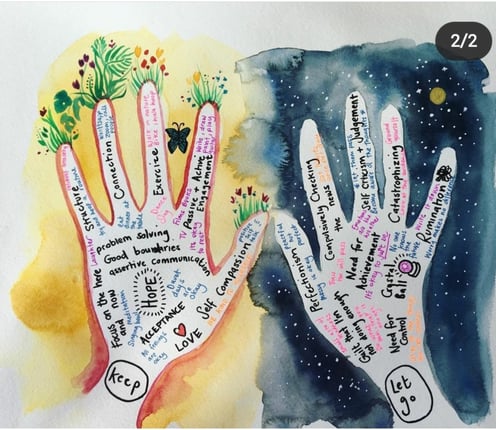
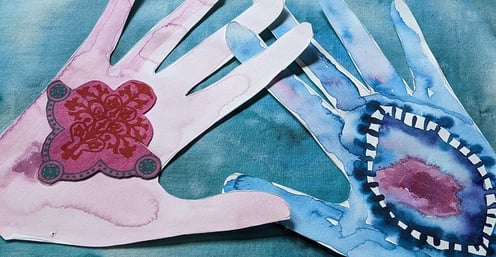
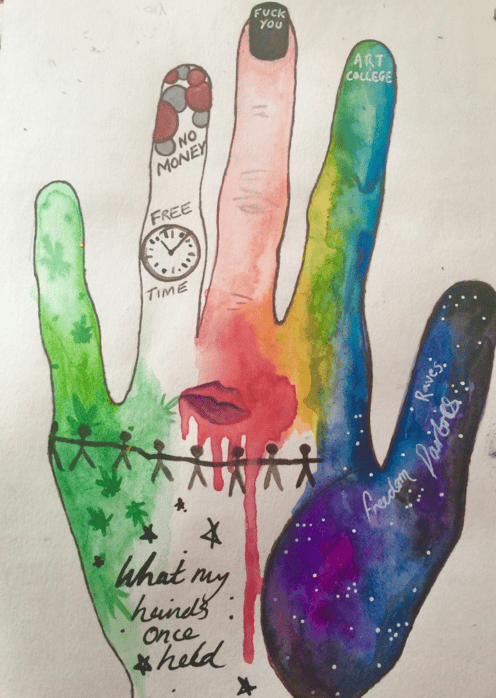
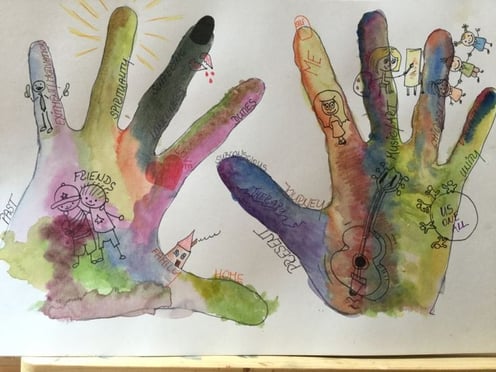
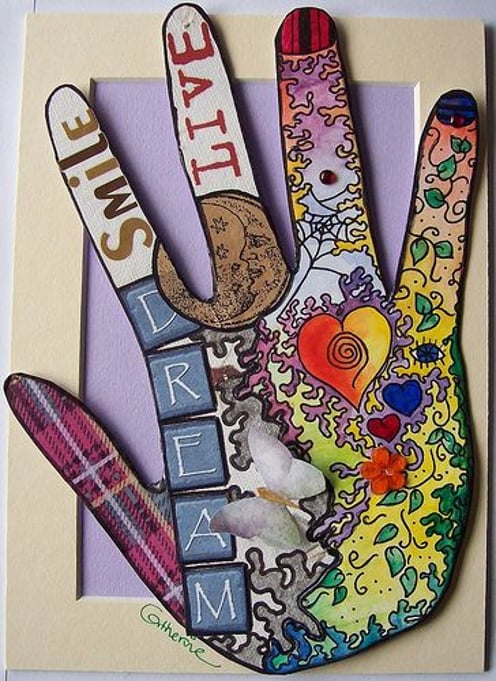
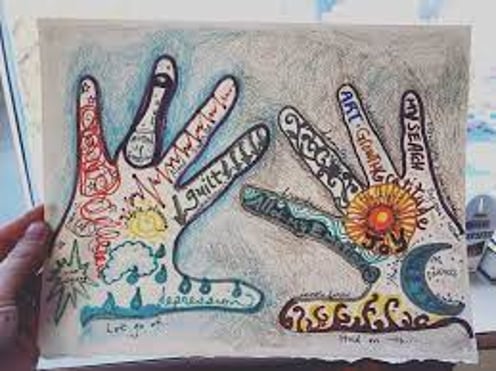
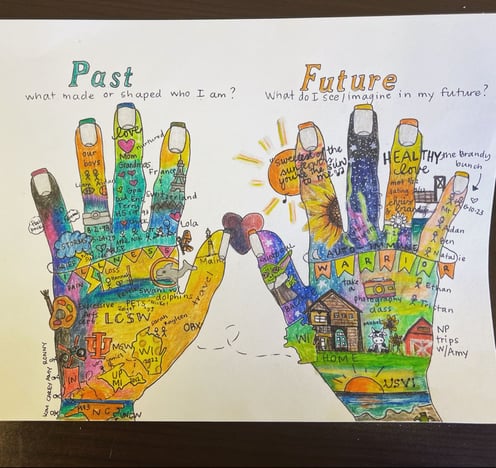







Personal Reflection
Prepare a Calm Space for Creative Exploration
Take a few moments to prepare a peaceful, nurturing space for yourself. You might begin by gently tidying the area and gathering any art supplies you’ll need. When you’re ready, light a candle or some incense to symbolize the start of this journey. If it feels soothing, put on some soft, relaxing music—acoustic, ambient, or nature-inspired sounds can help create a serene atmosphere. (If you’d like recommendations, consider exploring Yellow Brick Cinema on YouTube.) Let the gentle glow of the candle and the tranquil music guide you into a place of ease, inviting you to be fully present for this creative, healing session.
Activity 2 - Transforming Your Burdens
Art Supplies
2 sheets of paper
Glue stick
Your choice of drawing supplies (e.g., acrylic paint, felt markers, watercolours, crayons, coloured pencils)
Directions
Step 1: Listing Your Burdens
On your first sheet of paper, write down everything that feels heavy or burdensome in your life—old thought patterns, habits, relationships, past experiences, or even other people’s expectations. This is your chance to unload. Don’t censor yourself; fill the page with your honest thoughts.
Step 2: Releasing Tension
When you’re done writing, take that piece of paper and scrunch it into a tight ball. Put all your tension into that ball of paper and then rip it up into little pieces. Take your time to feel the lightness of the paper.
Step 3: Draw a Bird
Next, take your second sheet of paper and tune in to the energy of a bird. Nothing that represents freedom more so than a bird. Draw any kind of bird, focusing on an expansive wingspan. Don’t worry about accuracy or perfection; let your imagination guide you.
Step 4: Transforming Your Weighted Thoughts
Now, collage the torn pieces of paper onto your bird as if they were feathers. Each piece represents something that once weighed you down. Attach them carefully, building your bird slowly and mindfully. As you work, imagine what it would feel like not to carry those thoughts anymore. This is you acknowledging the past and letting it all go.
Step 5: Decorate Your Bird
Finally, decorate your bird in a way that speaks to freedom. Use colours, textures, or symbols that make you feel light, at ease, and at peace. Step back and reflect on how it feels to transform what once weighed you down into something that symbolizes flight and possibility.
From: Erica Pang Art
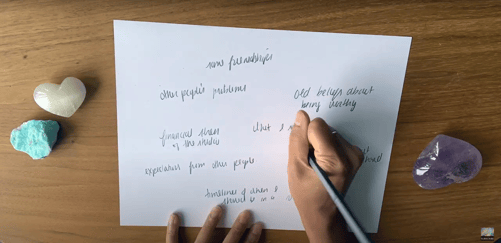

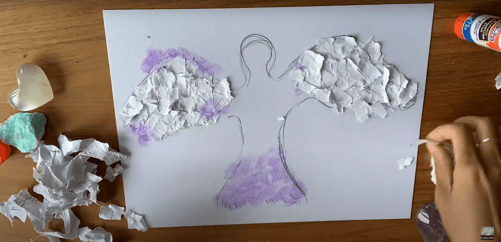
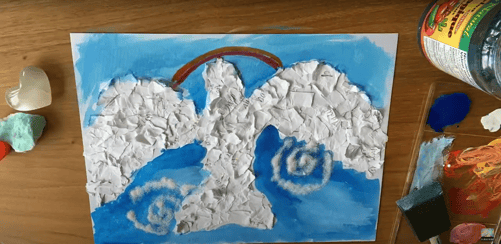
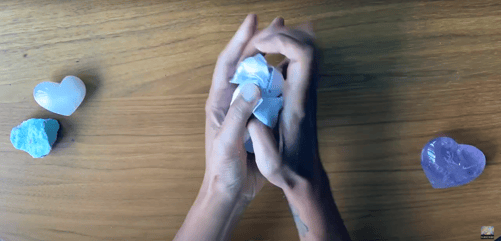
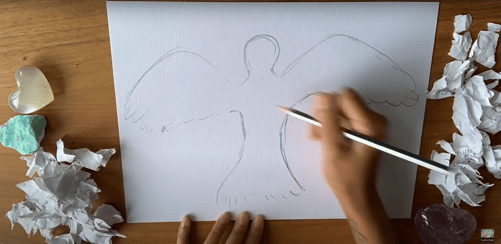
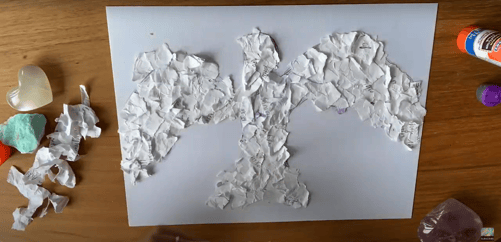
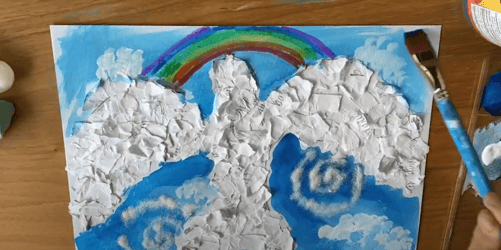








The Art of R.A.I.N.
When I was in college, I went off to the mountains for a weekend of hiking with an older, wiser friend of twenty-two. After setting up our tent, we sat by a stream, watching the water swirl around rocks, talking about our lives. At one point she described how she was learning to be “her own best friend.” A wave of sadness came over me, and I broke down sobbing. I was the furthest thing from my own best friend. I was continually harassed by an inner judge who was merciless, nit-picking, demanding, always on the job. My guiding assumption was, “Something is fundamentally wrong with me,” as I struggled to control and fix what felt like a basically flawed self.
Over the last several decades, through my work with tens of thousands of clients and meditation students, I’ve come to see the pain of perceived deficiency as epidemic. It’s like we’re in a trance that causes us to see ourselves as unworthy. Yet, I have seen in my own life, and with countless others, that we can awaken from this trance through practicing mindfulness and self-compassion. We can come to trust the goodness and purity of our hearts.
The RAIN Meditation
In order to flower, self-compassion depends on honest, direct contact with our own vulnerability. Compassion fully blossoms when we actively offer care to ourselves. To help people address feelings of insecurity and unworthiness, I often introduce mindfulness and compassion through a meditation I call the RAIN of Self-Compassion. The acronym RAIN, first coined by Michele McDonald, is an easy-to-remember tool for practicing mindfulness. The RAIN meditation has four steps:
Recognize what is going on
Allow the experience to be there, just as it is
Investigate with kindness, and
Nurture with loving presence.
R—Recognize What’s Going On
Recognizing means consciously acknowledging, in any given moment, the thoughts, feelings, and behaviors that are affecting us. Like awakening from a dream, the first step out of the trance of unworthiness is simply to recognize that we are stuck, subject to painfully constricting beliefs, emotions, and physical sensations. Common signs of the trance include a critical inner voice, feelings of shame or fear, the squeeze of anxiety or the weight of depression in the body.
Different people respond to the sense of unworthiness in different ways. Some might stay busy, trying to prove themselves valuable; others, fearful of failure, may become discouraged or even paralyzed. Still others may resort to addictive behaviors to avoid facing their shame and fear. Any of these strategies can lead to either defensive or aggressive behavior with others, or unhealthy attachment.
Some of us are at war with ourselves for decades, never realizing how our self-judgment and self-aversion keep us from finding genuine intimacy with others or enjoying our lives. One palliative caregiver reports that a key regret of the dying is not having been true to themselves. Rather than listening to and trusting our inner life, most of us try to live according to the expectations of others, which we internalize. When we inevitably fall short of the mark, we condemn ourselves.
Though it may sound depressing or overwhelming, learning to recognize that we are at war with ourselves is quite empowering. One meditation student described the trance of unworthiness as “…the invisible and toxic gas I am always breathing.” As he became increasingly mindful of his incessant self-judgment and feelings of inadequacy, his aspiration to free himself from his painful inner prison grew.
A—Allowing: Taking a Life-Giving Pause
Allowing means letting the thoughts, emotions, feelings, or sensations we have recognized simply be there. Typically when we have an unpleasant experience, we react in one of three ways: by piling on the judgment; by numbing ourselves to our feelings; or by focusing our attention elsewhere. For example, we might have the sinking, shameful feeling of having been too harsh in correcting our child. But rather than allowing that feeling, we might blame our partner for not doing his or her part, worry about something completely different, or decide it’s time for a nap. We’re resisting the rawness and unpleasantness of the feeling by withdrawing from the present moment.
We allow by simply pausing with the intention to relax our resistance and let the experience be just as it is. Allowing our thoughts, emotions, or bodily sensations simply to be doesn’t mean we agree with our conviction that we’re unworthy. Rather, we honestly acknowledge the presence of our judgment, as well as the painful feelings underneath. Many students I work with support their resolve to let it be by silently offering an encouraging word or phrase to themselves. For instance, you might feel the grip of fear and mentally whisper yes in order to acknowledge and accept the reality of your experience in this moment.
Victor Frankel writes, “Between the stimulus and the response there is a space, and in this space lies our power and our freedom.” Allowing creates a space that enables us to see more deeply into our own being, which, in turn, awakens our caring and helps us make wiser choices in life. For one student, the space of allowing gave her more freedom in the face of urges to binge eat. In the past, whenever she felt restless or anxious at night, she’d start thinking of her favorite food—trail mix—then mindlessly consume a half pound of it before going to bed, disgusted with herself. Learning to recognize the cues and taking a pause interrupted the pattern. While pausing, she would allow herself to feel the tension in her body, her racing heart, the craving. Soon, she began to contact a poignant sense of loneliness buried beneath her anxiety. She found that if she could stay with the loneliness and be gentle with herself, the craving passed.
I—Investigating with Kindness
Investigating means calling on our natural curiosity—the desire to know truth—and directing a more focused attention to our present experience. Simply pausing to ask, what is happening inside me?, can initiate recognition, but investigation adds a more active and pointed kind of inquiry. You might ask yourself: What most wants attention? How am I experiencing this in my body? Or What am I believing? What does this feeling want from me? You might notice hollowness or shakiness, then discover a sense of unworthiness and shame masked by those feelings. Unless you bring them into awareness, your unconscious beliefs and emotions will control your experience and perpetuate your identification with a limited, deficient self.
Poet Dorothy Hunt says that we need a “…heartspace where everything that is, is welcome.” Without such an attitude of unconditional care, there isn’t enough safety and openness for real investigation to take place. About ten years ago I entered a period of chronic illness. During one particularly challenging period of pain and fatigue, I became discouraged and unhappy. In my view I was terrible to be around—impatient, self-absorbed, irritable, gloomy. I began working with the RAIN meditation to recognize these feelings and judgments and to consciously allow the unpleasantness in my body and emotions to just be there. As I began to investigate, I heard an embittered voice: “I hate living like this.” And then a moment later, “I hate myself!” The full toxicity of self-aversion filled me.
Not only was I struggling with illness, I was at war with the self-centered, irritable person I believed I had become. Unknowingly, I had turned on myself and was held captive by the trance of unworthiness. But in that moment of recognizing and allowing the suffering of self-hatred, my heart began to soften with compassion.
Here’s a story that helps to describe the process I went through. Imagine while walking in the woods you see a small dog sitting by a tree. You bend down to pet it and it suddenly lunges at you, teeth bared. Initially you might be frightened and angry. But then you notice one of its legs is caught in a trap, buried under some leaves. Immediately your mood shifts from anger to concern. You see that the dog’s aggression sprang from vulnerability and pain.
This applies to all of us. When we behave in hurtful, reactive ways, it’s because we’re caught in some kind of painful trap. The more we investigate the source of our suffering, the more we cultivate a compassionate heart toward ourselves and others.
When I recognized how my leg was in a trap—sickness compounded with self aversion— my heart filled with sorrow and genuine self-care. The investigating deepened as I gently put my hand over my heart—a gesture of kindness— and invited whatever other feelings were there to surface. A swell of fear (uncertainty for my future) spread through my chest, followed by an upwelling of grief at losing my health. The sense of self-compassion unfurled fully as I mentally whispered, It’s all right, sweetheart, and consciously offered care to the depths of my vulnerability, just as I would to a dear friend.
Compassion arises naturally when we mindfully contact our suffering and respond with care. As you practice the RAIN of Self-Compassion, experiment and see which intentional gesture of kindness most helps to soften or open your heart. Many people find healing by gently placing a hand on the heart or cheek; others, in a whispered message of care, or by envisioning being bathed in warm, radiant light. What matters is that once you have investigated and connected with your suffering, respond by offering care to your own heart. When the intention to awaken self love and compassion is sincere, the smallest gesture—even if, initially, it feels awkward— will serve you well.
N—Nurture with Loving Presence
As you sense what is needed, what is your natural response? Calling on the most wise and compassionate part of your being, you might offer yourself a loving message or send a tender embrace inward. You might gently place your hand on your heart. You might visualize a young part of you surrounded in soft, luminous light. You might imagine someone you trust—a parent or pet, a teacher or spiritual figure—holding you with love. Feel free to experiment with ways of befriending your inner life—whether through words or touch, images or energy. Discover what best allows you to feel nurturing, what best allows the part of you that is most vulnerable to feel loved, seen, and/or safe. Spend as much time as you need, offering care inwardly and letting it be received.
The RAIN of Self-Compassion is not a one-shot meditation, nor is the realization of our natural awareness necessarily full, stable, or enduring. Rather, as you practice you may experience a sense of warmth and openness, a shift in perspective. You can trust this! The RAIN meditation is a practice for life—meeting our doubts and fears with a healing presence. Each time you are willing to slow down and recognize, oh, this is the trance of unworthiness… this is fear… this is hurt…this is judgment…, you are poised to de-condition the old habits and limiting self-beliefs that imprison your heart. Gradually, you’ll experience natural loving awareness as the truth of who you are, more than any story you ever told yourself about being “not good enough” or “basically flawed.”
A friend of mine was sitting with her dying mother while she was in a coma. At one point the mother opened her eyes, looked at her daughter with great lucidity, and said “You know, all my life I thought something was wrong with me.” She closed her eyes, sank back into a coma and died shortly thereafter. For my friend, her mother’s words were a parting gift. They inspired her to dedicate herself to the mindfulness and self-compassion that frees us.
We each have the conditioning to live for long stretches of time imprisoned by a sense of deficiency, cut off from realizing our intrinsic intelligence, aliveness, and love. The greatest blessing we can give ourselves is to recognize the pain of this trance, and regularly offer a cleansing rain of self-compassion to our awakening hearts.
Articles
Videos
Tara Brach Leads a Guided Meditation: The RAIN of Self Compassion (12 minutes)
Guided Meditation: Light RAIN in Difficult Times, with Tara Brach (9 minutes)
RAIN Meditation: Cultivating Mindful Awareness & Compassion with Tara Brach (55 minutes)
Transforming Your Relationship with Anxiety, with Tara Brach (51 minutes)
Continue Your Learning
Art Supplies
Feel free to use any materials you have on hand, such as:
Drawing: Pencils, markers, crayons
Painting: Watercolours, acrylics
Sculpting: Clay or any modeling material
Collage: Magazines, scissors, glue
Writing: Journals, pens
Creative Activity
Directions
Mindfulness and art practices are a very natural coupling. There are so many ways of weaving music, movement, art, and writing into this practice. This activity will incorporate writing and art making.
You can use any art and writing materials you have on hand. Arrange the materials on your working surface. Once settled, take a few deep breaths. It may help to close your eyes. As you breathe, begin a body scan. Begin with the top of your head and slowly bring your attention to each part of your body – noticing any feelings or sensations as you scan. Pause for a moment if an area seems to want more attention. Try to touch each area lightly with your awareness, without becoming carried away by your thoughts. Keep scanning your body until you reach the bottoms of your feet. Then take another few deep breaths and slowly open your eyes. When ready, move into the R.A.I.N. process.
Recognize
Begin by noticing any emotions or physical sensations that arose during the body scan. Once you have a felt sense, speak the word or words aloud. It might be a description such as “chest tight” or “constricted” or “grief.”
What art material feels like the right material to express the feeling? Pick up your art material and begin drawing, painting, or sculpting that particular sensation and feeling. It might be abstract or a representation of something. What color is the feeling or is it black and white? What about shape, texture, and size? Please follow your instinct and give the image time and space to form. Take as long as you need. When the art feels like it has come to a natural stopping point, move on to the next step.
Allow
Place your art object a little distance away. If it’s a two-dimensional drawing or painting, lean it up on the wall or tape it up. If it’s a three-dimensional piece, place it on a surface away from you. The idea here is to play with the physical distance between you and this part of you that is asking to be seen. How does it feel when you are far away from the art? Next, take a step closer. How does that feel? Move from side to side and also try standing directly in front of the image. Do you still notice the feeling inside as strongly or has the sensation lessened? There is no right or wrong here.
By creating the image you are allowing this feeling to take up physical space that is apart from you. You are able to witness the feeling while also being with the feeling. Lastly, can you hold the art piece? How does that feel in contrast to being further away from it? Place the art in a place that feels best and then move into the next step.
Investigate
Remember, the key is to investigate (not interrogate). Bring a quality of kindness to this step. While looking at the image, ask the image some questions. You might feel silly at first, but if you can trust the process here, you may be surprised and touched by your experience.
These questions might spontaneously emerge. But if not, here are some ideas. Ask your art things like: what are you choosing to share with me today? What do you need to feel finished, or do you feel complete? If you don’t feel complete, what would help you feel finished? How young or old is the part of me that created you? Do you feel appreciated, seen, and heard? Where would you like to live in my home at this moment? Imagine that you could shrink yourself into a tiny size and live in the art piece. Which part of the art piece would you dwell in and which part would you avoid?
I encourage you to have a pen and paper on hand. Write down the questions and any answers that emerge during the art dialogue. The answers are coming from a deeper part of you. The art is there to help facilitate the dialogue with yourself.
Nurture
As you dialogue with your art, you may automatically realize the best ways to nurture yourself. Taking time out of your day to create and reflect is an act of self-nurturing. Sometimes a very clear and actionable answer might emerge. For example, you could feel inclined to take a hot bath, go on a walk outside, or continue journaling. You might feel pulled to create more artwork. Often a new art series can emerge out of this mindfulness practice. If it feels right, keep the art in a visible place so that it serves as a daily reminder to nurture yourself.
It’s important to say that at times it feels too challenging to stay with a strong emotion. If you go through these steps and feel unsettled, it can be very nurturing to tell your feeling “I know that you need my attention. I promise to return to you and do more self-discovery work in the near future. But for now, I’m taking a break.” If the emotion feels too big, imagine that you have a chest or box in the room. Visualize yourself safely placing the emotion in that box and closing the lid. Again, reminding the emotion that you can come back soon to spend more time with it.
After you finish your artwork, grab a pen and notebook and write down your answers to the following questions:
1) What emotions or sensations did I notice during the process, and how did creating art help me express or understand them?
2) How did my experience of allowing and nurturing my feelings change as I engaged with my artwork?
3) In what ways did the RAIN practice provide me with new insights about myself or my emotional landscape?
4) How can I apply the lessons learned from this activity to my daily life and future experiences with challenging thoughts and emotions?
Set an Intention
Before you begin, I invite you to close your eyes and take a few deep breaths. Let yourself be here right now in this moment. Turn your attention inwards, place your palms face down on the paper in front of you, and set an intention for this creative exercise. You may choose to say aloud or silently in your heart, "With gentle curiosity, I delve into my inner landscape, embracing the emotions that arise. As I create, I honour the journey within, allowing my art to be a window into my heart and mind." Give the paper gratitude for holding space for you today.
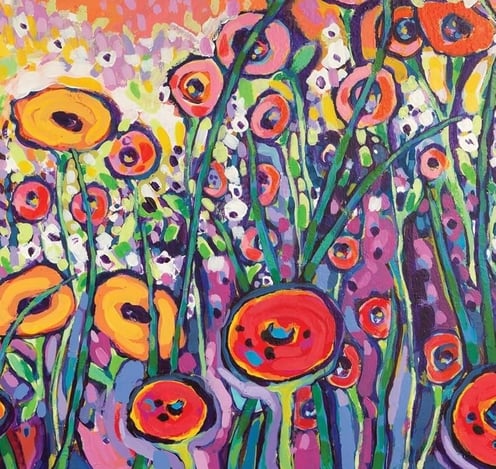
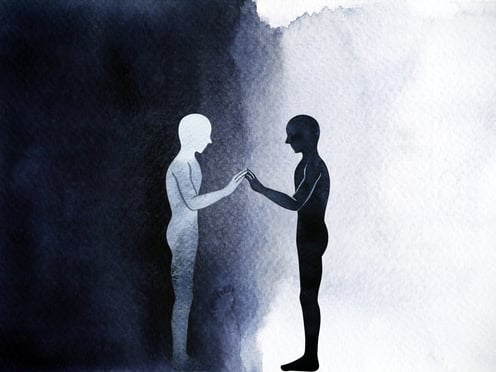
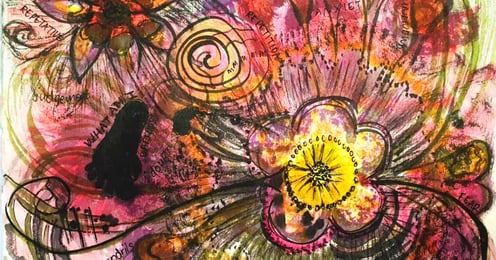
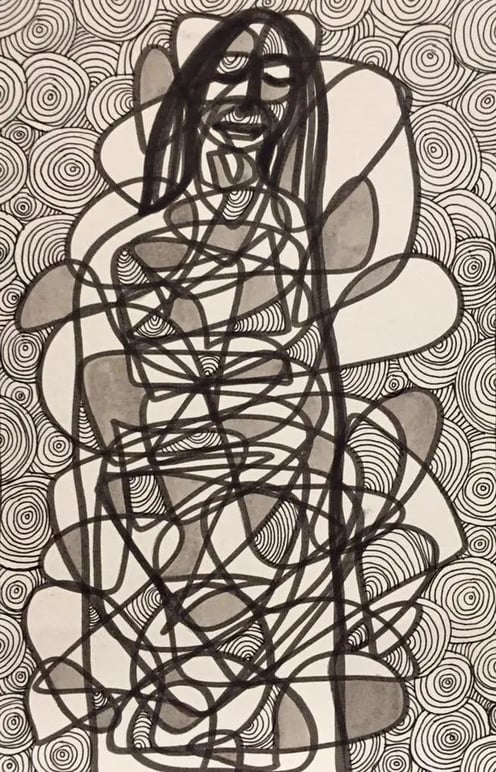
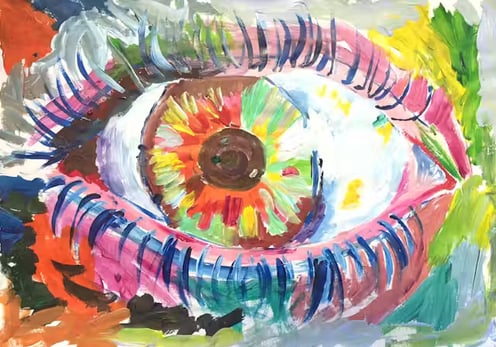
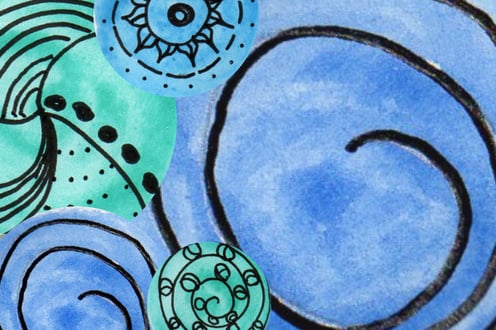
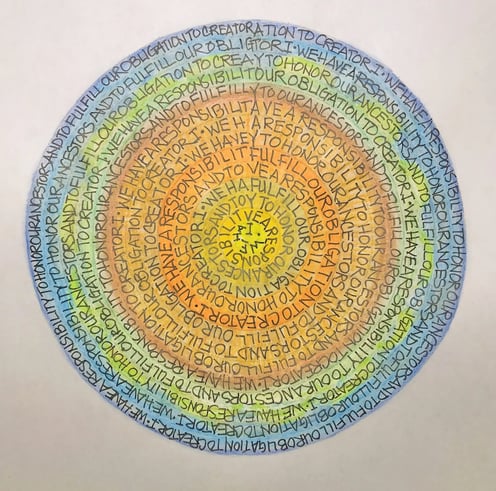
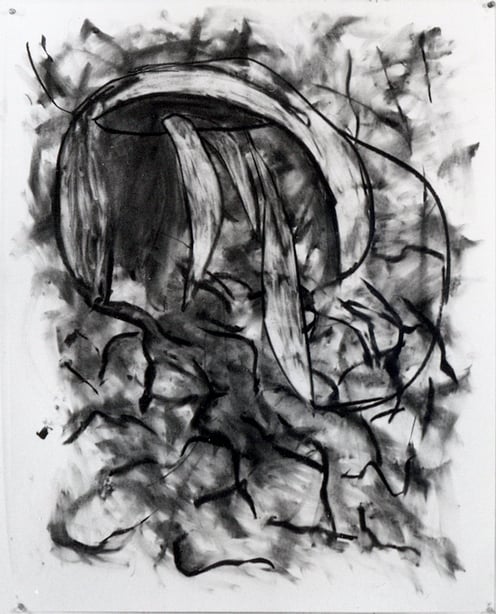
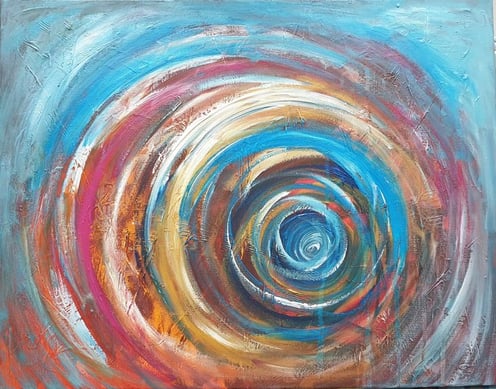











Personal Reflection
Prepare a Calm Space for Creative Exploration
Take a few moments to prepare a peaceful, nurturing space for yourself. You might begin by gently tidying the area and gathering any art supplies you’ll need. When you’re ready, light a candle or some incense to symbolize the start of this journey. If it feels soothing, put on some soft, relaxing music—acoustic, ambient, or nature-inspired sounds can help create a serene atmosphere. (If you’d like recommendations, consider exploring Yellow Brick Cinema on YouTube.) Let the gentle glow of the candle and the tranquil music guide you into a place of ease, inviting you to be fully present for this creative, healing session.
The Art of Your Golden Shadow
“We resist the more noble aspects of our shadow more strenuously than the dark sides” – Robert Johnson
In Jungian psychology, the “shadow” refers to an unconscious aspect of the personality, everything of which we are not fully conscious of. To some, the shadow represents the suppressed areas in our life and that can include the positive as well as the negative. Yet, for many of us, we often resist the more noble aspects of our shadow more strenuously than the dark sides.
When we speak of our shadows, we often associate them with the more shameful and darker aspects of our unconscious. However, as Swiss psychologist Carl Jung understood, there is another aspect of our submerged creative potential that he referred to as our Golden Shadows.
These are the amazing, powerful, exceptional, gifted parts of ourselves that we do not own, and instead keep hidden and project onto others. As with all shadow projections, we see these aspects in others instead of in ourselves. For example, we might idolize others for their beauty, talent, determination, or power, while denying and disconnecting from our own.
In the spirit of becoming a more balanced and integrated human, and more authentic in our engagement with ourselves and with each other, being curious about the darkness within is a profound way of discovering hidden gold.
Making the Darkness Conscious
“Too much of the animal distorts the civilized man, too much civilization makes sick animals.” - Carl Jung
Having a shadow is a part of being human. We all have one and we all have a dark side. It was necessary to repress certain aspects of our animality when we were growing up.
In order to fit into our immediate cultural dynamic, in order to be civilized and a healthy, functioning member of society, it was an important and healthy thing to tone down our wildness, our unbridled frenzy, our violence, our unthinking spontaneity and learn some discipline.
This became our repressed darkness, our shadow. Making the darkness conscious is an artform. It’s a precarious endeavor, a delicate and dangerous undertaking. But no other practice is more vital to human flourishing. No other task is as critical for achieving balance and integration.
As Jung famously said, “One does not become enlightened by imagining figures of light, but by making the darkness conscious.”
This is because the shadow is primal. It’s wild and intuitive. It’s umbilical. In our youth it was necessary to repress it in order to achieve discipline; in our maturity, it is vital that we integrate it in order to achieve enlightenment.
It must be reconciled lest it fester and spread and poison us. If we simply ignore the shadow, it will just become stronger, darker, angrier. It will become demonic and domineering, to the extent that it will eventually possess us like mere puppets under a dark unforgiving cloud.
It takes fierce courage to face our darkness and it takes ruthless questioning to get past the comfortable “answers” that we’ve settled for. It takes tender vulnerability to get past the rigid invulnerability that we’ve erected to keep ourselves “safe.”
But nothing is more important than making the darkness conscious, especially when our goal is healthy integration, wholeness, balance, self-actualization and enlightenment.
Mining the Gold
“Heroes are meant to be forged golden from the blaze.” - Nikita Gill
Once we’ve made the darkness conscious, we can begin the important task of sacred excavation. But it won’t be easy. The only thing harder than mining for gold in the shadow is making the darkness conscious.
This is because the shadow is turbulent and fierce. It’s an unbridled furnace of molten energy where all our repressed anger, grief, shame, guilt and wildness has boiled into a raging frenzy.
Mining for gold in such an environment is not for the faint of heart. A good strategy, going into it, is to harness the archetypal power of the Phoenix (the personified life-death-rebirth process).
By pitting one archetype (Phoenix) against another (Shadow), we will be more courageous and adaptable when facing the burning and more likely to gain the resilience of rebirth.
Easier said than done, but the discovery of gold makes it all worth it. For this type of gold reinforces our confidence and courage. It bolsters our self-esteem. It makes us more resilient, more imaginative and more spiritually robust. It reveals hidden talents, repressed passion and stifled creativity.
The interesting thing is that in order to gain the courage needed to mine for gold in the shadow, one must already have the courage to make the darkness conscious.
It’s like George Orwell’s paradoxical quote: “Until they become conscious they will never rebel, and until after they have rebelled they cannot become conscious.”
The good (and bad) thing about the Unconscious is that it works behind the scenes despite consciousness. If we’re lucky enough to have a life experience that triggers our unconscious into giving us the much-needed courage to make the darkness conscious, in the first place, we’ll be able to bolster our courage through the discovery of our shadow’s gold, in the second place.
In the end, having made the darkness conscious, having been forged by the fire, having resurrected into a mighty Phoenix, we will have excavated sacred gold from the shadows and unveiled our deepest passions, hidden talents, fierce wildness, and innate creativity.
From these sacred artifacts, we can continue the reconciliation of the shadow and the cultivation of our authenticity.
With our mighty shadow by our side, as ally rather than enemy, as wholeness rather than dissociation, as diamond rather than demon, a cloak of antifragility dons our character and the path of self-overcoming and enlightenment widens before us.
From: The Golden Shadow: Stepping into the Power of Who You Really Are
Articles
Videos
Continue Your Learning
Art Supplies
Old magazines
Scissors
Glue stick
Large sheet of paper or cardstock (for the collage base)
Markers or pens
Creative Activity
Directions
This is a spontaneous creative activity designed to help you step away from conscious thinking and let your intuition take the lead. No planning, no analyzing—just let your creativity flow freely without overthinking. Through this process, you’ll explore your "golden shadow," uncovering positive traits and qualities within you that you might not consciously recognize.
Step 1: Choose Your Images
Start by flipping through magazines, but here’s the key: don’t be intentional about it. Instead, let your eyes guide you to images or words that stand out. Don’t worry about why—just go with what feels right in the moment. Cut out what you’re drawn to without trying to figure out the meaning.
Step 2: Create Your Collage
Once you have a collection of images and words, casually arrange them on your sheet of paper or cardstock. Don’t overthink it. Just start placing things where they feel like they belong. Let your arrangement be spontaneous and fun—there’s no right or wrong way to do it.
Step 3: Glue Everything Down
When you’re happy with the placement, go ahead and glue everything down. Trust your gut on where each piece should go. This is your subconscious expressing itself, so let it surprise you.
Step 4: Reflect on Your Creation
Now that your collage is finished, take a moment to look at it. What do you like or love about it? What stands out? Start to think about the positive aspects, skills, or personality traits the images and words represent. Write down the traits you admire, using words like: Confident, Creative, Grounded, Generous, Insightful, Honest, Brave, Playful, or any other qualities that resonate with you. These words reveal parts of your golden shadow—your hidden strengths.
From: Discover Your Golden Shadow With Expressive Art Therapy
After you finish your artwork, grab a pen and notebook and write down your answers to the following questions:
1) What surprised you about the images or words you chose?
2) What emotions came up for you while creating your collage?
3) Which images or words do you feel most connected to, and why?
4) What positive traits or qualities do you see reflected in your collage?
5) How does this collage represent aspects of yourself that you may not always acknowledge?
6) Are there any qualities in your collage that you wish to embrace more in your life?
Set an Intention
Before you begin, I invite you to close your eyes and take a few deep breaths. Let yourself be here right now in this moment. Turn your attention inwards, place your palms face down on the paper in front of you, and set an intention for this creative exercise. You may choose to say aloud or silently in your heart, “I invite myself to be open and curious, allowing my inner wisdom to guide me. I release the need for perfection or control and trust that whatever emerges in this process reflects the beauty and strength within me that I may not yet fully see.” Take a moment to give the paper gratitude for holding space for you today.

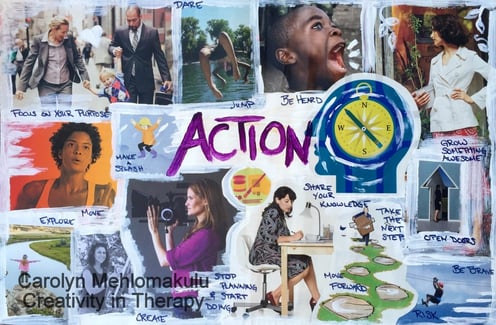
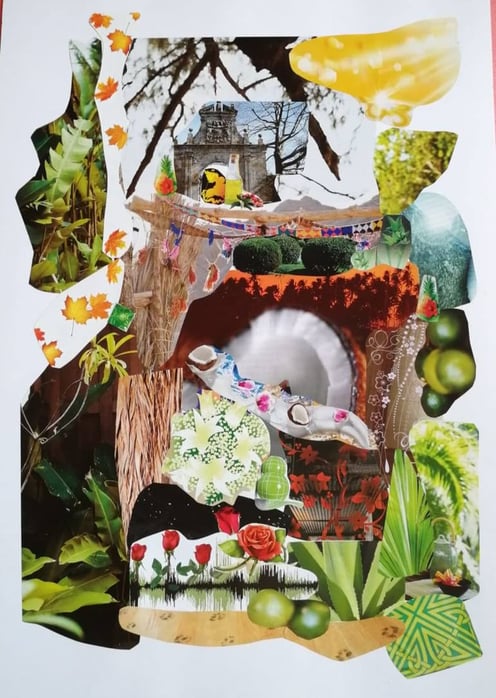
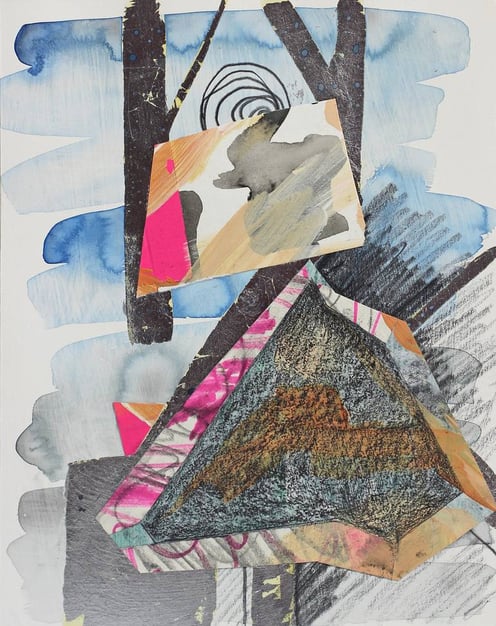

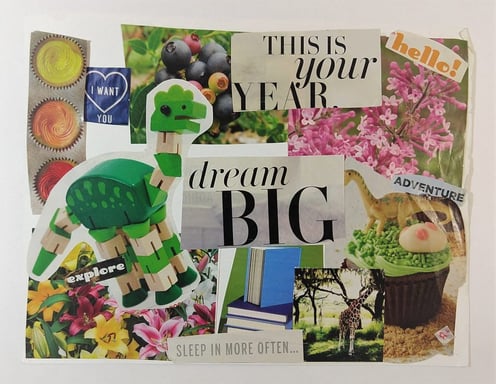
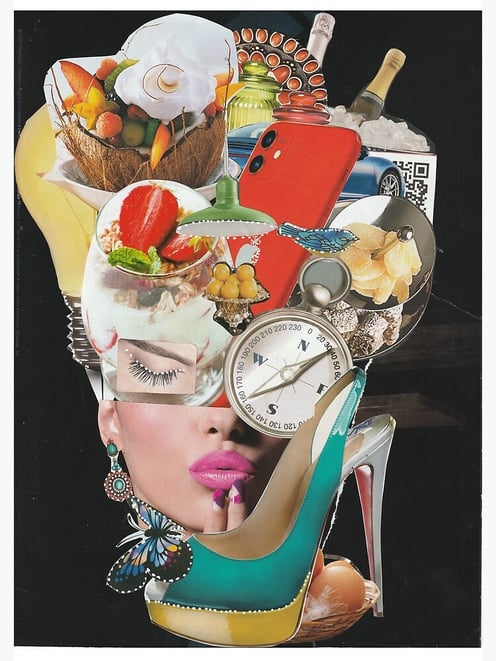

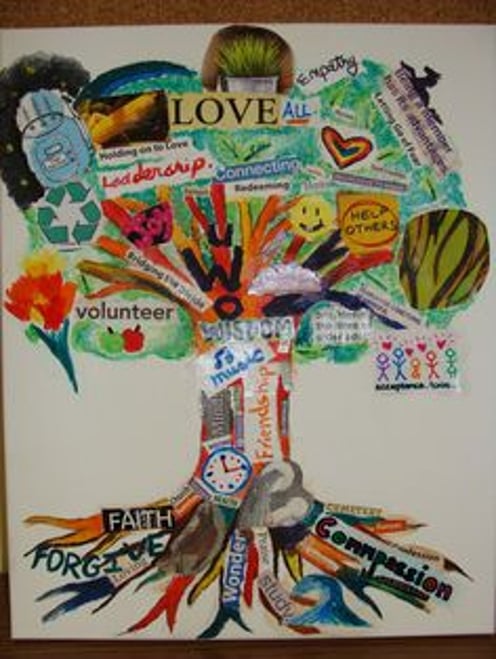

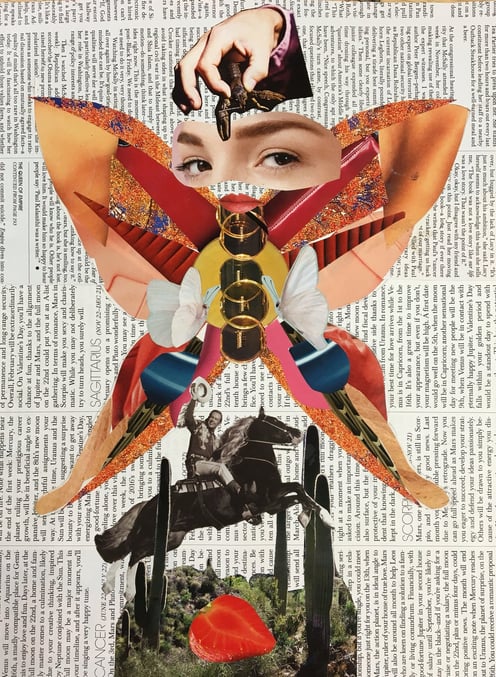











Personal Reflection
Prepare a Calm Space for Creative Exploration
Take a few moments to prepare a peaceful, nurturing space for yourself. You might begin by gently tidying the area and gathering any art supplies you’ll need. When you’re ready, light a candle or some incense to symbolize the start of this journey. If it feels soothing, put on some soft, relaxing music—acoustic, ambient, or nature-inspired sounds can help create a serene atmosphere. (If you’d like recommendations, consider exploring Yellow Brick Cinema on YouTube.) Let the gentle glow of the candle and the tranquil music guide you into a place of ease, inviting you to be fully present for this creative, healing session.
The Art of Shadow Work
How well do you know yourself?
If you’re like most people, you probably have a decent idea about your own desires, values, beliefs, and opinions.
You have a personal code that you choose to follow that dictates whether you are being a “good” person.
If there is any one thing you can know in this universe, surely it is who you are.
But what if you’re wrong?
What if much of what you have come to believe about yourself, your morality, and what drives you is not an accurate reflection of who you truly are?
Now, before you launch into a, “Hey, you don’t know me, you don’t know my life, you don’t know what I’ve been through!”-style defence, ponder this for a second:
Have you ever said or done something really shitty, mostly on an impulse, that you later regretted?
After the damage was done and the other person involved was hurt, you couldn’t bury your shame fast enough. “Why did I say that?” you might have asked yourself in frustration.
It’s that “Why?” question that indicates the presence of a blind spot. And though the reason for your reaction may have been obvious (perhaps even “justified”), the lack of control you had over yourself betrays the existence of a different person lurking beneath your carefully constructed idea of who you are.
If this person is coming into focus for you, congratulations—you’ve just met your shadow self.
We all have parts of ourselves that aren't necessarily our favorites, from doubts and fears to guilt and shame. These so-called bad aspects of ourselves make up the "shadow self," but the good news is, when you learn to embrace your shadow self, you can live a more balanced life. Here's how, according to experts.
What is the "shadow self"?
The shadow self refers to parts of yourself—whether personality traits, emotions, thoughts—that are difficult to accept. As licensed clinical psychologist Claire Nicogossian, Psy.D., explains to mbg, you often don't want to acknowledge, identify, or embrace these things.
There's a reason the shadow is often ignored or denied: These qualities don't fit in with our conceptions of ourselves.
For example, she says, consider someone who has a core belief that feeling resentment in motherhood correlates with being ungrateful or a bad mom. "Instead of embracing their shadow self [and] experiencing anger or frustration at times toward her child or a situation in her life impacting her as a mom, she ignores or denies or thinks she's less than because she's having the feeling or thought or experience," Nicogossian explains.
It was famed psychoanalyst Carl Jung who popularized the idea of the shadow self, licensed therapist and co-founder of Viva Wellness Jor-El Caraballo, LMHC, tells mbg.
Jung believed the shadow holds repressed thoughts and feelings, Caraballo notes—not all of which are necessarily "bad": "Jung believed that positive traits could be held in the shadow if those parts of ourselves were invalidated or minimized by others, leading us to repress those parts of ourselves."
Do we all have a shadow?
Jung believed everyone has a shadow self. As Nicogossian adds, we all come into the world open and free of judgment, but as we get older, we have experiences that cause us to judge ourselves.
Whether from parents, relatives, teachers, or society as a whole, Nicogossian explains that when we receive messages about what's acceptable and what's not, those unacceptable things about ourselves are pushed into the shadow.
Jung believed, however, that one of the best things we can do is work toward accepting and integrating the shadow rather than continuing to reject it, Caraballo explains.
"With that kind of exploration, he believed that we could successfully incorporate and work through these repressed thoughts and feelings and experience greater internal peace rather than being unconsciously driven by shadow self needs and feelings (like we normally are)," he adds.
How to embrace your shadow self:
1) Become a curious observer.
As Nicogossian explains, shadow work is fundamentally about bringing disowned parts of yourself and your experience to the light through awareness, curiosity, and intention. You do so when you "notice patterns and themes that keep showing up in your life," she says. The more you learn to witness your mind, the more you'll see how and when your shadow self influences you.
2) Practice nonjudgment toward yourself.
As you learn to witness and observe your mind and your shadow, Nicogossian says to do so without judgment or putting yourself down. "When you experience a shadow emotion, allow yourself to experience the shadow emotion without judging yourself or the feeling," she adds.
3) Work with a professional.
Of course, as with any deep inner healing work, it can be tremendously helpful to work with a professional. Caraballo notes that shadow work can be difficult, as it's hard to move something from your unconscious mind to your conscious mind all on your own—and it can be intense and even overwhelming in its own right. Having someone there to help can go a long way.
"Be sure to find a counselor who is nonjudgmental, supportive, caring, and with whom you feel safe to explore the shadow side of yourself, which is, in essence, embracing vulnerability with self-compassion," Nicogossian adds.
4) Meditate.
Meditating is a great way to learn how to observe your mind and practice nonjudgment. Caraballo says insight-driven meditation practices can help people develop greater consciousness and learn to not only accept but embrace shadow emotions.
5) Try shadow journaling.
Caraballo recommends shadow journaling as you're getting started on your shadow work journey. The benefit of journaling is it allows you to get all those thoughts out of your head and onto paper, offering a deep opportunity for reflection. Refer to some of the prompts below if you're unsure where to start!
Exercises and prompts to get started:
1) Label your emotional experiences.
Get into the habit of labeling your emotional experiences in detail, Nicogossian suggests. (You can write them down or mentally reflect.)
For example, if you're feeling sad, she says, "Go a little deeper and ask yourself: What kind of sadness am I feeling? Perhaps lonely, depleted or exhausted, or hopeless? The more descriptive and specific in labeling emotions, the more awareness is created, which helps identify what you need to do to take care of your emotional health."
2) Think about someone who triggers you.
Caraballo says thinking of a recent experience in which you came across someone who really annoyed or frustrated you can help you quickly access your shadow. "Take a moment to consider what it was specifically that felt so bothersome about this person or what they were doing or saying," he explains. "Then, take a moment to reflect on how what you observed in this person could be reflective of some deeper part of you."
Ask yourself if you often criticize yourself for the same behavior, or if this person reminds you of someone who has wronged you. "The answers to those questions might provide space for deeper reflection and facilitate a connection to the shadow self," Caraballo adds.
3) Dig deep with specific questions.
Lastly, Nicogossian recommends asking yourself thoughtful questions about your own shadow self from time to time. As you're learning to witness your shadow, here are some questions she suggests:
Are your thoughts critical statements about yourself? A relationship? An interaction or a situation?
What are some of the messages you have received about experiencing a specific shadow emotion?
When you were younger, were you allowed to feel shadow emotions, or were you shamed or judged or punished for having these experiences?
Did you learn to ignore or avoid shadow emotions because of lack of support early on?
Have you ever been met with anger or overwhelm when you shared your feelings in a significant relationship?
The bottom line.
We all have a shadow, and while learning to integrate and embrace it might not be easy, it's so worth it. As Nicogossian says, accepting the shadow self creates space to understand and process our experiences, which allows for both positive change and healing.
From: Shadow Self-101: What It Is & How To Embrace It, According To Experts
Carl Jung and the Shadow: The Ultimate Guide to the Human Dark Side
Articles
The Essential Guide to Shadow Work: Integrate Your Wounded Parts + Live Your Authentic Self
The Benefits of Shadow Work and How to Use It in Your Journey
Carl Jung and the Shadow: The Ultimate Guide to the Human Dark Side
Videos
Projecting Your Personal Shadow | Dr. Steve Mortenson (15 minutes)
What Is Shadow Work? - Teal Swan (10 minutes)
Shadow Work: What It Is & When To Do It (31 minutes)
Continue Your Learning
Art Supplies
Watercolour paper
White wax crayon or white oil pastel
Watercolour paints
Assorted watercolour brushes
Creative Activity
Directions
We all carry aspects of ourselves that we've been taught to see as undesirable, and in this creative activity, you'll have the opportunity to bring these aspects into awareness with compassion. Using a process called wax relief, you'll write your shadow traits on a sheet of paper in a way that allows them to remain unseen. Then, you’ll bring everything into the light by layering a watercolor wash over the paper, revealing what has been hidden. This activity is an opportunity to embrace and understand your full self, transforming what was once concealed into an expression of your true identity.
Step 1: Understanding Shadow Traits
What are shadow traits?
Shadow traits are parts of ourselves that we’ve rejected, denied, or hidden because we believe they’re unacceptable. Carl Jung coined the term "Shadow Self" to describe these aspects that we suppress in order to feel accepted, loved, and safe. Shadow traits aren’t always socially perceived as negative and we’ll be exploring this in a future lesson. Some examples of both negative and positive shadow traits are:
Self-Doubt: You may struggle with persistent self-doubt, feeling unsure of your abilities and decisions. This can prevent you from taking risks or pursuing opportunities, as you often question your worth and capabilities.
Impatience: You may have developed a tendency to be impatient, feeling frustrated when things don’t go your way or when others don’t meet your expectations. This can create tension in relationships and prevent you from appreciating the process of growth and change.
Creativity: You might have grown up in a home that prioritized performance in math and science, learning that creativity and the arts were unimportant. This could have led you to deny your identity as an artist or creative person.
Assertiveness: If you grew up in a family or community that valued humility, giving, and sacrifice, you might have learned that being bold, selfish, or putting yourself first was unacceptable.
Step 2: Identifying Your Shadow Traits
Using a white crayon or oil pastel, write down your shadow traits on a piece of watercolour paper. You may also want to draw symbols or images that represent your shadow traits. Be free and messy—let the words and shapes flow without overthinking or analyzing.
For this activity, try to focus on the shadow traits that you feel are challenging or negative. Don’t worry; you’ll have the opportunity to explore your positive shadow traits in a future lesson.
You can use these prompts to help identify your shadow traits:
Prompt 1: Think of someone in your life who really irritates you. What specific behaviours of theirs trigger a reaction in you? (e.g., arrogance, bossiness, loudness). The traits you dislike in others can often reflect hidden traits that we have disowned within ourselves.
Prompt 2: Consider recurring issues in your life. Are you often surrounded by angry people, or attention seekers? We often attract people and situations that reflect traits we’ve denied in ourselves.
Prompt 3: Ask yourself: What do I worry others will find out about me? What am I trying to hide? The things you’re embarrassed about often point to your shadow traits.
Step 3: Bringing Your Shadow Traits to Light
Now it’s time to reveal your shadow traits by washing watercolours over your invisible writing.
Choose colours that resonate with you: You might feel drawn to dark, muddy colours like greens, blues, browns, and blacks to represent the heaviness of the shadow. Or, you might choose light, bright colours like pinks, yellows, and blues to bring a sense of acceptance and love to these hidden parts of yourself.
Be intuitive and free with how you apply the paint. Be messy as you move, swirl, and blend the paint around the page. This isn’t about technique or aesthetic—focus on what feels right to you.
From: Shadow Work Self Reflection Art Activity | Therapeutic Art Journaling
After you finish your artwork, grab a pen and notebook and write down your answers to the following questions:
1) How did it feel to explore parts of yourself that you usually keep hidden?
2) Were there any shadow traits that surprised you? Why or why not?
3) How do you think these shadow traits have influenced your behaviour or decisions?
4) What was the experience of revealing your shadow traits through the watercolor process like for you?
5) Did any of your shadow traits feel difficult to acknowledge? If so, why do you think that is?
6) How might accepting these shadow traits lead to a greater sense of self-awareness or self-acceptance?
Set an Intention
Before you begin, I invite you to close your eyes and take a few deep breaths. Let yourself be here right now in this moment. Turn your attention inwards, place your palms face down on the paper in front of you, and set an intention for this creative exercise. You may choose to say aloud or silently in your heart, "May this creative journey guide me in uncovering the hidden parts of myself with compassion and curiosity, allowing me to embrace my shadow and transform it into a source of wisdom and growth. Through this exploration, I open myself to deeper self-awareness and a sense of wholeness." Take a moment to give the paper gratitude for holding space for you today.
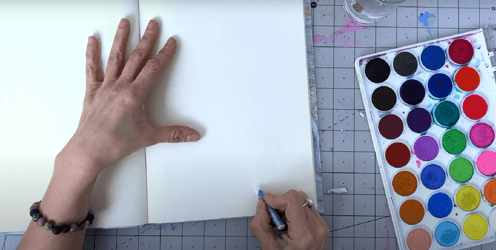

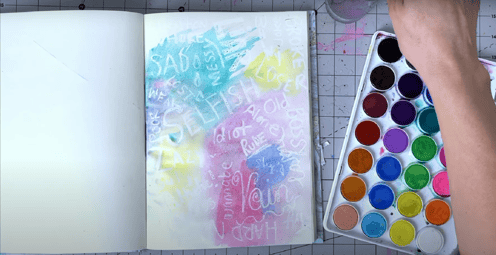


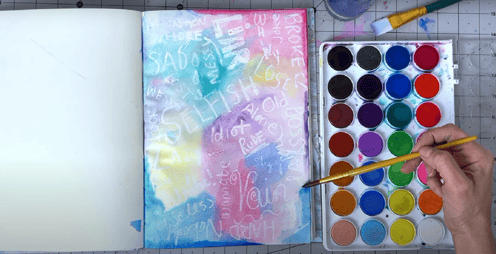






Personal Reflection
Prepare a Calm Space for Creative Exploration
Take a few moments to prepare a peaceful, nurturing space for yourself. You might begin by gently tidying the area and gathering any art supplies you’ll need. When you’re ready, light a candle or some incense to symbolize the start of this journey. If it feels soothing, put on some soft, relaxing music—acoustic, ambient, or nature-inspired sounds can help create a serene atmosphere. (If you’d like recommendations, consider exploring Yellow Brick Cinema on YouTube.) Let the gentle glow of the candle and the tranquil music guide you into a place of ease, inviting you to be fully present for this creative, healing session.
The Art of Fear
“The only way to ease our fear and be truly happy is to acknowledge our fear and look deeply at its source.”
– Thich Nhat Hanh
Fear. It’s a dark passenger that accompanies us in life. It’s in our excuses, indecision, insecurities, and worry. It rides along as we ruminate on past failures. Arguably, fear is the thing that holds us back from doing the hard things and realizing our fullest potential.
“Fear haunts all of us, especially women,” says San Francisco Bay Area blogger and influencer Julie Lignon. “For some, it is fear of the unknown, fear of what’s next. For others, it is fear of not being good enough, strong enough, smart enough. … Sometimes we fear our light will shine too bright, or that if another woman shines, there won’t be enough light for us.”
Whether it feels like your fears are as big as an elephant sitting on your chest, disabling you from making your move, or as incessantly irritating as a determined bee buzzing in your ear, you’ll discover that while there’s no way to irradicate your fears completely, with a little practice, you can actually befriend what scares you and learn to use it to your advantage.
And on that note, be cautioned that your fears are unlikely to evaporate overnight. In most cases, your brain has spent decades developing these thoughts and feelings, and it’s important to give yourself time and grace in this unraveling process that can be difficult, even painful. “Like any skill worth having, it takes time to build our courage muscles, and we’re more likely to succeed by building and climbing our personal courage ladder one rung at a time from the bottom,” says Jim Detert, author of the forthcoming book, Choosing Courage: The Everyday Guide to Being Brave at Work and professor at the University of Virginia’s Darden School of Business.
A Biological Beast
So what is fear, exactly? Turns out, your brain’s not an expert at distinguishing between different threat levels. “[Fear] is our biological response to danger or perceived danger—perceived being the keyword,” says Libby Gill, a Los Angeles-based executive coach and award-winning author of You Unstuck. “We are hardwired to avoid danger, and the amygdala, our brain’s fear center, makes no distinction between actual physical danger like getting eaten by a tiger and perceived danger, like raising our hand to speak in a meeting of senior managers.”
In addition, our brains store past fears in a phenomenon that scientists call “fear memory consolidation.” As part of our natural defense system, fear memories have such strong and lasting influence that they can impact behavior for years. For example, if you felt that you made a fool of yourself giving a speech in high school, a fear of public speaking can follow you into your professional life and prevent you from becoming an effective communicator. These biological responses to frightening or humiliating situations can mean that your fears are deep rooted, painfully personal, and sometimes even irrational.
Befriend Your Fears
The first step in understanding your fears is to know them, and journaling is a healthy way to start that process. “Journaling is one of the most powerful tools to use when figuring out what’s holding you back,” says Ellen Torreyson, a certified professional coach with a BA in psychology from the University of Texas in Austin. Torreyson suggests writing down what’s eating you, whether it’s ending a toxic relationship, writing your first novel, or applying for a job promotion. Wait a few minutes, then write down even more—keep wringing out your brain until you get all your thoughts on paper.
Then, she said, go down the list and ask yourself why three to five times to dig deeper. For example:
“I want to quit my job and start a new business, but I’m afraid I won’t have enough money.”
Why?
“I think I need to have $__ in the bank before I can quit.”
Why?
“I want to maintain the same quality of life that I have now.”
Why?
“I don’t want anyone to judge me or talk about me or think less of me.”
(Whoa.)
By distilling your thoughts down to figure out your true fears, you can begin to replace the negative thought patterns that don’t serve you with ones that do. You may need to do this over and over again or even enlist the help of an accountability partner or professional coach, but eventually, those fears will subside or at least become manageable, Torreyson said.
Don't Live Up to Expectations
When you’re ready to begin dismantling what’s holding you back, be prepared to mentally transport back to your early days. As children, we often are given labels that we wear into our adult lives and these labels can translate into fears and limitations. You may have been told you were “not an athlete,” you were “mean,” or you were “lazy.” These labels then give us license to make excuses for why we can’t do something.
“Sometimes we unintentionally hang on to labels of the past, those emotional remnants that may or may not have been true in the first place,” Gill says. “Maybe your parents or a former boss labeled you as ‘cold’ or ‘mean,’ so you’ve avoided having the tough conversations that are often necessary in business, in case you come off as mean. If you reframe that label to ‘direct’ or ‘straight-forward,’ it can empower you to give feedback without feeling cold or heartless.”
Focus On the Good
We have approximately 60,000 thoughts going on in our minds throughout the day, and what we put our energy to is what gets solidified in the subconscious mind, says Aureen M. Monteiro, author of RISE HIGHER: 9 Steps for a Woman to Overcome Any Challenge, Become the Leader She Deserves To Be & Do What She Loves. However, she warns, the subconscious mind cannot differentiate between what is real and what is merely a thought. So when you’re having a serious case of imposter syndrome in your new job, whether or not you can actually handle the job doesn’t resonate in your subconscious—just the fact that you think you can’t does. That’s why it’s so important to focus on what you want, rather than what you don’t want.
“Even if you are in a difficult situation, the fact that you are still alive and thinking means you are strong and facing the adversity head-on; pat yourself on your back,” Monteiro says. “Being grateful for all you have gives you the strength.”
The Great Motivator
Fear is not always negative and, in fact, it can be a powerful motivator, according to Amy Jo Palmquest, 36, of Olympia, Washington, who used her fear to open up her own training studio. “I had been a trainer and a nutritionist for years, but I knew I wanted to impact more people,” Palmquest explains. “Honestly, I was scared to death. A new lease, multiple people counting on me, juggling being a mom, a business owner, and wife. I was petrified.”
But Palmquest forged on. The fear never fully went away, but she learned how to use it. “I would say the petrifying fear has subsided over the years, but I always have what I call a ‘healthy fear’ in the back of my mind,” Palmquest says. “This fear continues to challenge me to do more, to reach more people, to never be complacent or satisfied with where I’m at. My healthy fear keeps me driving forward for even greater things to come.” Now, five years later, Palmquest is celebrating a thriving business that helps transform people’s lives for the better.
Sink or Swin, Just Dive In
If you’re a perfectionist at heart, we’ll bet that you have a hard time just getting the thing done. If you’re waiting until your novel or business plan is “perfect” before you share it with the world, then, spoiler alert, it will never be released, says James Patrick, a business coach, podcast host, and internationally published photographer from Phoenix, Arizona.
“The only true thing that can get you closer to perfection is releasing your ideas to market and paying attention to the feedback you get from your audience or your clients on how to better your offerings,” Patrick says. “An imperfect idea that’s launched will become infinitely more successful than the perfect idea that never sees the light of day.” In other words, it almost doesn’t matter if you fail or if you succeed—the lessons you learn from taking action will be the very fuel you need to succeed later.
While the path to reframing and overcoming your fears is a guaranteed uphill battle, the rewards that are waiting for you are undoubtedly worth the fight. “At the end of the day, it’s up to you and you alone to do what it takes to get to your dream destination or live your dream life,” said Monteiro. “What will you do to start living courageously?”
Articles
Videos
Continue Your Learning
Art Supplies
Mixed media paper
Colouring supplies of your choice (markers, coloured pencils, crayons, paint)
Pencils or pens (for sketching or writing words/symbols)
Something circular to trace around (like a small bowl or round object)
Creative Activity
Directions
In this activity, you’ll gently explore a fear you’ve been holding onto and create a space to reflect on it through art. By visualizing your fear and surrounding it with comforting elements from your life, you can begin to see how your sources of safety and support can help contain and manage that fear. Be kind to yourself as you sit with these difficult feelings. This exercise is about understanding your fear and knowing that you have sources of comfort that can help you manage it. Take all the time you need to reflect and feel what comes up.
Step 1: Start by Acknowledging Your Fear
Take a deep breath and think about a fear that’s been on your mind. If it feels right, start with something small and manageable to ease into the process.
Step 2: Draw a Circle
Draw a circle in the middle of your paper. Inside this circle, try to express your fear. It can be a symbol, a feeling, words, or even just a color that represents what your fear looks or feels like.
Step 3: Pause and Reflect
Take a moment to look at what you’ve placed in the circle. How does it feel to see your fear there? Does it seem contained within the circle? Notice any emotions that come up as you observe your fear.
Step 4: Invite Comfort and Safety In
Now, think about the things in your life that make you feel safe, loved, or calm. It could be people, favourite places, possessions, or activities that bring you joy and peace.
Step 5: Surround Your Fear with Comfort and Safety
Outside the circle, start drawing or representing your sources of comfort, safety, love, and calm. Let them surround your fear. You can use shapes, colours, words, or symbols that feel comforting or safe to you.
Adapted from Art Therapy Resources
After you finish your artwork, grab a pen and notebook and write down your answers to the following questions:
1) How did it feel to represent your fear visually? Did anything surprise you about the way it took shape on the page?
2) What emotions came up when you surrounded your fear with comforting elements? Did you notice a shift in how you felt toward your fear as you added those safe parts of your life?
3) Do you feel that your sources of comfort can help you manage or reduce the impact of your fear? How might you lean on these supports when your fear feels overwhelming?
4) Looking at your completed artwork, how do you feel now compared to when you started? Has your perspective on your fear changed, even in a small way?
Set an Intention
Before you begin, I invite you to close your eyes and take a few deep breaths. Let yourself be here right now in this moment. Turn your attention inwards, place your palms face down on the paper in front of you, and set an intention for this creative exercise. You may choose to say aloud or silently in your heart, "Today, I invite myself to explore my fears with curiosity and compassion. Through creative expression, I will confront the emotions and thoughts that arise, allowing myself the space to acknowledge my fears without judgment. As I transform them onto the page, I create room for clarity, healing, and inner strength." Take a moment to give the paper gratitude for holding space for you today.
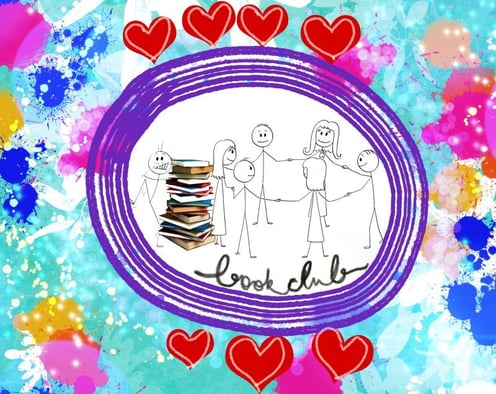



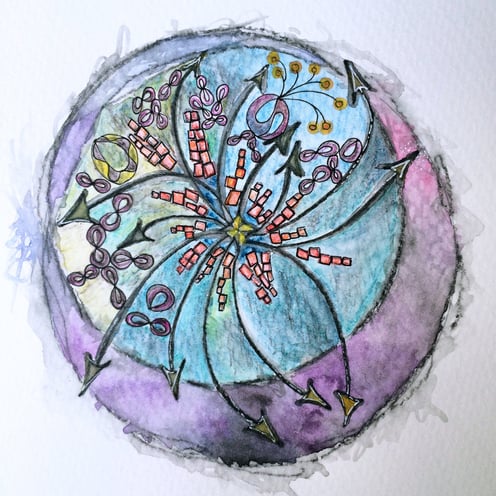
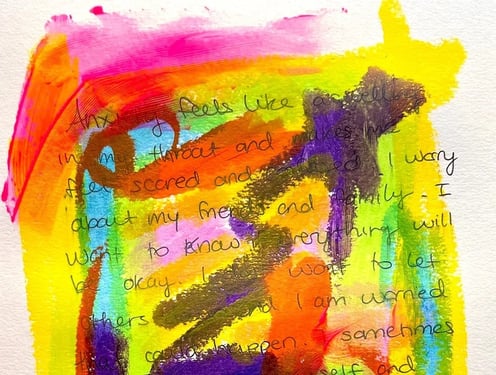
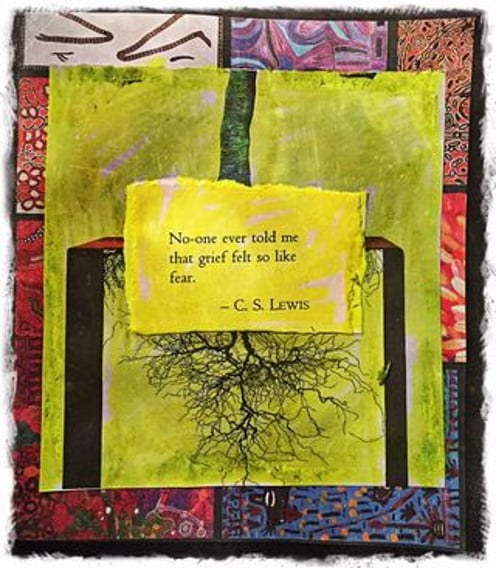









Personal Reflection
Prepare a Calm Space for Creative Exploration
Take a few moments to prepare a peaceful, nurturing space for yourself. You might begin by gently tidying the area and gathering any art supplies you’ll need. When you’re ready, light a candle or some incense to symbolize the start of this journey. If it feels soothing, put on some soft, relaxing music—acoustic, ambient, or nature-inspired sounds can help create a serene atmosphere. (If you’d like recommendations, consider exploring Yellow Brick Cinema on YouTube.) Let the gentle glow of the candle and the tranquil music guide you into a place of ease, inviting you to be fully present for this creative, healing session.
The Art of Visual Journaling
Visual journaling is like keeping an artistic diary. Whether you call it a visual journal, a sketchbook, a gluebook, or an art diary, this is a space to create, explore, meditate, and practice. It’s a space free of judgment, where nothing needs to be completed or made perfect. Your visual journal is just for you.
Some of us keep a daily diary, while others turn to their notebook occasionally to get something off their chest. Whatever the case, journaling can be a useful tool for dealing with mental clutter, processing emotions, and maintaining good mental health.
But what if you don’t enjoy writing? What if the idea of having to put your feelings into words just doesn’t sound like fun?
Many of us are visual people—we understand the world through images, shapes, and colours, rather than words. If this sounds like you, then visual journaling might be just what you need.
What is a Visual Journal?
A visual journal is just like a traditional journal, but instead of written entries, it contains drawings, sketches, hand lettering, doodles, or even clippings of photographs and magazine cutouts. It’s a collection of your feelings, thoughts, ideas, and dreams in visual form.
Do you have to be artistic to keep a visual journal? Not at all! Just like a diary, visual journaling is a very personal practice—it’s not meant to be judged, compared, or criticized. Anyone can keep a visual journal—it doesn’t matter if you’re a skilled artist or you haven’t picked up a marker since elementary school.
What's the Purpose of Keeping a Visual Journal?
People take up visual journaling for many different reasons. The practice is very personal, so each journaler receives exactly what they need.
These are just a few of the most commonly experienced benefits of keeping a visual journal:
1. It’s Cathartic
In the same way that talking to a friend about an issue helps us feel better, visual journaling can help release negative emotions, understand a problem, and come up with potential solutions. Letting our minds focus on drawing allows us to slow down our thoughts and witness emotions surfacing in unexpected ways.
2. It’s a Chance to Practice Vulnerability
Many of us tend to suppress and ignore our emotions for the sake of appearing strong and resilient. Though it can help us feel better in the short term, this mindset can be detrimental in the long run. Taking up visual journaling forces us to practice being vulnerable on a regular basis.
3. It’s an Opportunity for Self-Reflection
Visual journaling doesn’t just help uncover negative emotions—it also gives us a chance to get to know ourselves better. What do we like? What makes us feel happy? What inspires us? Intentionally seeking the answers to these questions can help create more peace and balance in our lives.
4. It Helps Develop a Habit of Creativity
Creativity and self-expression are vital components of a happy and fulfilling life. However, most of us don’t dedicate enough time for creative hobbies. Keeping a visual journal helps create this habit. Even sitting down to draw for just 10 minutes a day can make a massive difference in our wellbeing. For aspiring artists and professionals, keeping a daily journal and cultivating a habit of creativity is the first step to developing their skills and mastering their craft.
5. It’s a Source of Inspiration
If you’re a creative person, you’ve probably faced a creative block at one point or another. You’ve felt completely uninspired and unable to come up with any new ideas. Visual journaling can help remedy this—when you use visual writing prompts and express yourself freely, new creative ideas flow more easily, often from a place you never thought to look.
6. It’s a Way to Set Intentions
How do you keep track of your plans and goals? If you’re a visual thinker, drawing your intentions may be the best way to manifest them into existence. Try drawing your dream house, city, or job. You can even turn your visual journal pages into a vision board to serve as a reminder of what you’re working towards.
How to Start a Visual Journal
Now that you have a few visual journal ideas, let’s take a look at how you can get started. This process will look different for everyone, but here are the basic steps.
Step 1: Gather Your Materials
You can absolutely journal on loose sheets of paper, but a dedicated notebook will help you develop a visual journaling habit and make the practice feel more intentional. You can use any notebook you have laying around, or invest in something with thicker paper, such as a Strathmore visual journal.
When it comes to drawing materials—pencils, markers, crayons, or paint— choose whatever you enjoy working with most (but don’t be afraid to switch it up every now and then). Keep in mind that visual journaling is more about getting your thoughts onto paper, rather than making it look beautiful, so choose something that is easy to use and doesn’t take too much time.
Regardless of what materials you choose, it’s always a good idea to have a simple black marker on hand for lettering, outlining, and adding simple embellishments.
Step 2: Pick a Prompt
Visual journaling from a prompt isn’t always necessary—sometimes it’s clear what we need to get off our chests. However, if you really want journaling to become a regular practice, you’ll likely face days when you’re not quite sure where to start.
That’s where prompts come in. They give a clear framework for your journaling and help your mind go to places you wouldn’t have ever thought to explore.
Consider jotting down a few prompts at the front or the back of your journal so you can refer to them any time you’re looking for visual journal ideas. Here are some prompts to get you started:
Something that inspires you
Something you hate
Something you want
Something you fear
Something on your mind at the moment
Step 3: Set Parameters
It may seem counterintuitive, but setting rules and restrictions for your visual journal entry will actually help you get more out of your journaling session.
When decisions like which colors to use and how big your drawing should be are made right at the start, the mind can focus all of its attention on the creative work. In other words, the less guesswork you have to do, the better. Before you start, choose three to four colors that you’re drawn to in the moment. When it comes to the size of your drawing, consider adding a frame or using a templated layout, such as a grid with four quadrants.
Step 4: Draw and Reflect
Here’s where the fun begins! There are really no guidelines for this step—simply begin creating and see where your mind takes you.
You can start with a few words or phrases that come to mind, then embellish them with colors and doodles. Or you can start with an illustration and add a few words to finish off your entry.
The key here is to avoid planning your drawing in advance. Remember that your entry doesn’t have to be perfect—your journal is for you and no one else. Plus, mistakes can often turn into delightful surprises, so embrace them and go with the flow.
As you’re journaling, think about what your drawings have in common. Is there a theme or a certain atmosphere in your entries? Reflecting on this is exactly what will help uncover what’s truly on your mind.
From: A Guide to Starting a Visual Journal: Prompts, Examples, and Inspiration
Articles
Videos
Study Hall: Visual Journaling (19 minutes)
Visual Journaling: Lesson 1 | FUNDAMENTALS with Justina Stevens (24 minutes)
Writing About Ordinary Life in a Visual Journal (4 minutes)
Art Journaling for Beginners (15 minutes)
Continue Your Learning
Art Supplies
Journal or sketchbook
Coloured markers, pens, pencils, crayons
Watercolour or acrylic paints and brushes
Collage materials like magazines, old book pages or photos for cutouts
Scissors and glue stick if you’re incorporating collage
Optional supplies: gel pens, stamps and ink pads, stickers, washi tape, decorative papers
Creative Activity
Directions
Instead of providing written instructions, I've included a video with five unique exercises, each guided by a different teacher, to introduce you to the practice of visual journaling. These exercises are designed to spark creativity, encourage self-reflection, and help you connect with your inner thoughts and emotions in a safe, supportive way. Give yourself permission to explore each exercise at your own pace, whether you choose to try them all or focus on the one that resonates most with you. Embrace the process as an opportunity for personal expression and emotional release, trusting that whatever emerges is a meaningful part of your creative journey.
After you finish your artwork, grab a pen and notebook and write down your answers to the following questions:
1) What aspects of myself are emerging through my art, and how do they reflect who I am today?
2) How can I use this creative practice to cultivate peace, balance, or joy in my life?
3) What do I need to release or let go of, and how can this journal page help me process that?
4) How do I feel about the unfinished or imperfect aspects of my work, and what do they teach me about my own growth?
Set an Intention
Before you begin, I invite you to close your eyes and take a few deep breaths. Let yourself be here right now in this moment. Turn your attention inwards, place your palms face down on the paper in front of you, and set an intention for this creative exercise. You may choose to say aloud or silently in your heart, "Today, I choose to honour my journey by releasing what no longer serves me. Through this creative process, I will explore the emotions and thoughts tied to what I hold onto, gently acknowledging them and allowing them to flow out of me. With each stroke, I open my heart to acceptance, trusting that by letting go, I'm creating space for new growth, peace, and self-compassion." Take a moment to give the paper gratitude for holding space for you today.
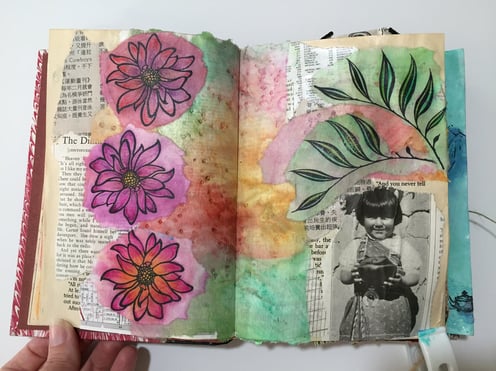

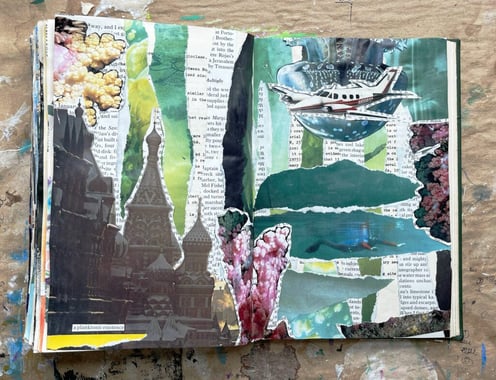
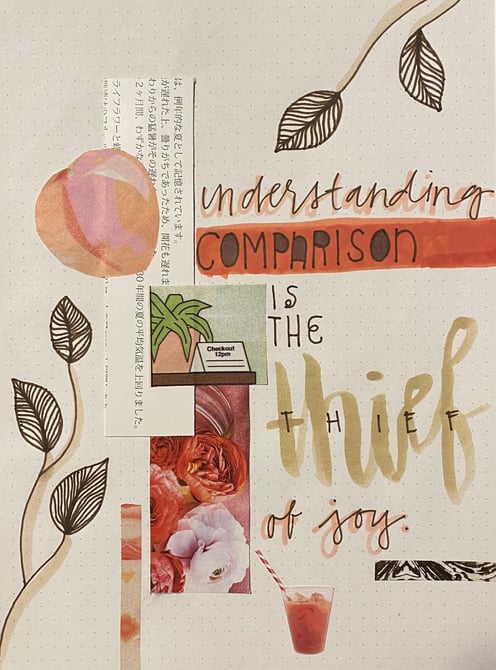
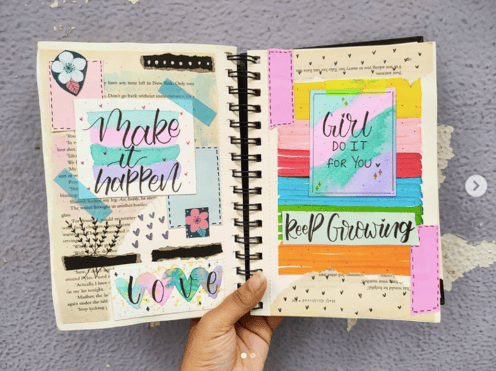
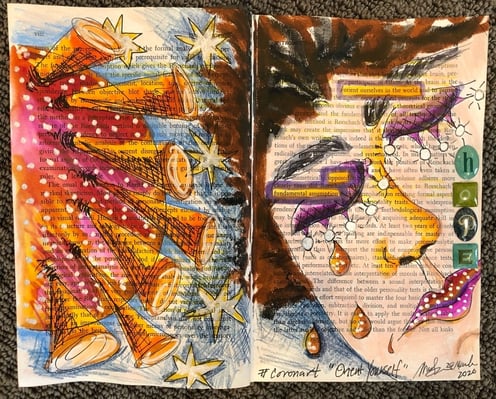
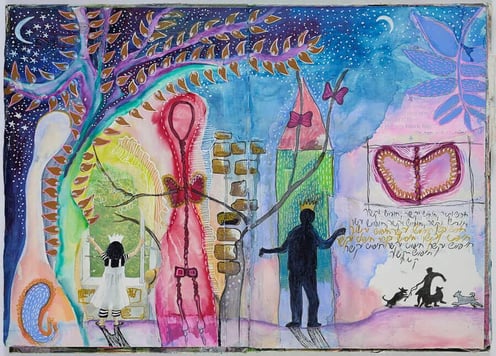
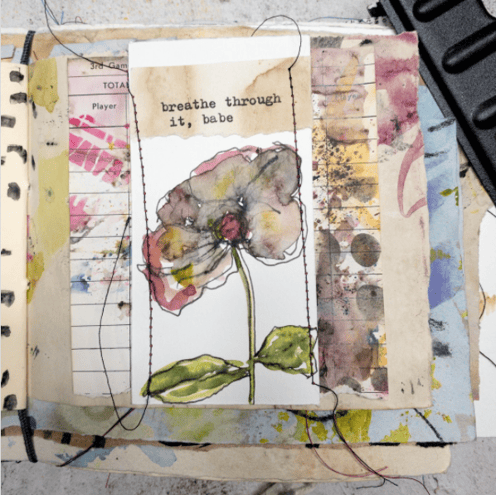








Personal Reflection
Additional Visual Journaling Prompts
To begin, select an image that resonates with you—whether from a magazine, a book, or from the internet. Then, grab your journal and a pen or pencil, and get ready to start your creative exploration.
Prompt 1
Why did you choose the image you chose? What about it spoke to you? Think about the things that drew you to it, what does it symbolize? What was attractive about it?
Prompt 2
Where are you in the image? Spend time finding yourself in the image in front of you. This could mean right now, or where you would like to be, or where you have been. Where is your experience, hopes, or struggles in the image you have chosen? Where would you like to be in the image?
Prompt 3
Write a story about your image. This can be complete fantasy, or it can be the story that the image is trying to tell you. If you are a religious person this might be the story that the Divine is trying to tell you through the image. If you are not it might be the story your subconscious is trying to communicate to you. Don’t worry about form, or plot. Just tell yourself a story and see where it goes.
Remember, this is for you and your own spirit. There is no judgement, there is no “good or bad,” You don’t even have to pay attention to grammar or sentence structure. Give yourself permission to let go and explore.

Prepare a Calm Space for Creative Exploration
Take a few moments to prepare a peaceful, nurturing space for yourself. You might begin by gently tidying the area and gathering any art supplies you’ll need. When you’re ready, light a candle or some incense to symbolize the start of this journey. If it feels soothing, put on some soft, relaxing music—acoustic, ambient, or nature-inspired sounds can help create a serene atmosphere. (If you’d like recommendations, consider exploring Yellow Brick Cinema on YouTube.) Let the gentle glow of the candle and the tranquil music guide you into a place of ease, inviting you to be fully present for this creative, healing session.
The Art of Grief and Loss
"When after heavy rain the storm clouds disperse, is it not that they’ve wept themselves clear to the end?"
— Ghalib
Grief is one of the heart’s natural responses to loss. When we grieve we allow ourselves to feel the truth of our pain, the measure of betrayal or tragedy in our life. By our willingness to mourn, we slowly acknowledge, integrate, and accept the truth of our losses. Sometimes the best way to let go is to grieve.
It takes courage to grieve, to honor the pain we carry. We can grieve in tears or in meditative silence, in prayer or in song. In touching the pain of recent and long-held griefs, we come face to face with our genuine human vulnerability, with helplessness and hopelessness. These are the storm clouds of the heart.
Most traditional societies offer ritual and communal support to help people move through grief and loss. We need to respect our tears. Without a wise way to grieve, we can only soldier on, armored and unfeeling, but our hearts cannot learn and grow from the sorrows of the past.
To meditate on grief, let yourself sit, alone or with a comforting friend. Take the time to create an atmosphere of support. When you are ready, begin by sensing your breath. Feel your breathing in the area of your chest. This can help you become present to what is within you. Take one hand and hold it gently on your heart as if you were holding a vulnerable human being. You are.
"The grief we carry is part of the grief of the world. Hold it gently."
As you continue to breathe, bring to mind the loss or pain you are grieving. Let the story, the images, the feelings comes naturally. Hold them gently. Take your time. Let the feelings come layer by layer, a little at a time.
Keep breathing softly, compassionately. Let whatever feelings are there, pain and tears, anger and love, fear and sorrow, come as they will. Touch them gently. Let them unravel out of your body and mind. Make space for any images that arise. Allow the whole story. Breathe and hold it all with tenderness and compassion. Kindness for it all, for you and for others.
The grief we carry is part of the grief of the world. Hold it gently. Let it be honored. You do not have to keep it in anymore. You can let it go into the heart of compassion; you can weep.
Releasing the grief we carry is a long, tear-filled process. Yet it follows the natural intelligence of the body and heart. Trust it, trust the unfolding. Along with meditation, some of your grief will want to be written, to be cried out, to be sung, to be danced. Let the timeless wisdom within you carry you through grief and awaken a tender, open heart.
Keep in mind that grief doesn’t just dissolve. Instead it arises in waves and gradually, with growing compassion, there comes more space around it. The heart opens and in its own time, little by little, gaps of new life—breaks in the rain clouds appear. The body relaxes and freer breaths appear. This is a natural cycle you can trust—how life and the heart renews itself. Like the spring after winter, it always does.
From: A Meditation on Grief
Articles
Videos
7 Signs You're Not Dealing with Your Grief and Loss (7 minutes)
Why We Don't "Move On" from Grief (11 minutes)
None of Us Can Escape Catastrophe (5 minutes)
Grieving and Timeless Love, with Tara Brach (58 minutes)
Continue Your Learning
Art Supplies
Paper
Assorted drawing materials like pastels, coloured pencils, markers, paint
Pen or pencil
Scissors
Fabric
Needle and thread
Clay
Scrapbooking materials like old magazines
Any other materials of your choice
Creative Activity
Directions
Step 1: Loss/Grief Expression
Tune into your body. Take 3-5 deep breaths, slowly.
Notice where in your body you are experiencing grief and loss. Place your hand on this part of you. Notice any colours or sensations.
Create a representation (using the materials) of your body’s felt sense of this grief and loss. Give all the hurt, pain, sadness, anger, and frustration form.
When it feels finished, take a pause and have a look at what you have created. If it had a name what would it be called?
Placing the representation/expression somewhere nearby with any of the objects/symbols you collected that relate to this loss.
Sitting with your creation, what do you see? What surprises you about it? What do you notice? If it could speak what would it say to you? What does it need from you?
Step 2: Response Expression
From the first creation, now make something in response. It might be a response to what the creation said to you, maybe it needed acknowledgement, love, or just to be seen and heard? Maybe it wanted to be free, to be let go? Maybe it wanted to tell you what you need to be focusing on in the future? What unmet needs do you want to focus on going forward?
This representation holds the purpose of giving you something to take with you in your next steps forward. Focus on what you need to put in your tool kit and what supports you need to put in place for the next steps. Routine creates safety and confidence. What routines do you need for yourself?
Step 3: Releasing
Draw or write on a piece of paper what you feel ready to release. There’s no right or wrong, and you don’t have to let go of anything right now—just follow what feels right for you in this moment.
To honour the process of releasing, you may want to bury this paper, rip it or burn it. While you are doing this, announce out loud about what you are releasing, for example, “I release the need to please others… I release the fear that I will not be okay going forward… I release and honour the connection I had with this person, and now I let it go…” Then, thank yourself for having the courage to do this.
From: Art Therapy for Letting Go
After you finish your artwork, grab a pen and notebook and write down your answers to the following questions:
1) What emotions came up for you during the creative process?
2) How do you feel when you look at what you’ve created?
3) What message does your creation hold for you?
4) What does your creation need from you to feel acknowledged or understood?
5) How does the second creation reflect your needs or desires for the future?
6) What supports do you need to put in place to move forward with confidence?
Set an Intention
Before you begin, I invite you to close your eyes and take a few deep breaths. Let yourself be here right now in this moment. Turn your attention inwards, place your palms face down on the paper in front of you, and set an intention for this creative exercise. You may choose to say aloud or silently in your heart, "I honour my pain, embracing each tear as a step towards healing. In this moment, I allow myself to feel, to grieve, and to grow." Take a moment to give the paper gratitude for holding space for you today.

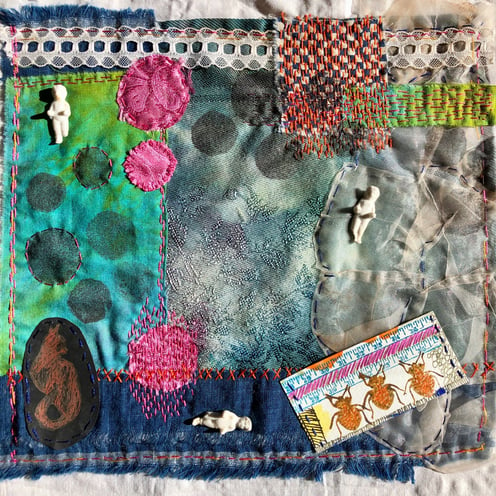
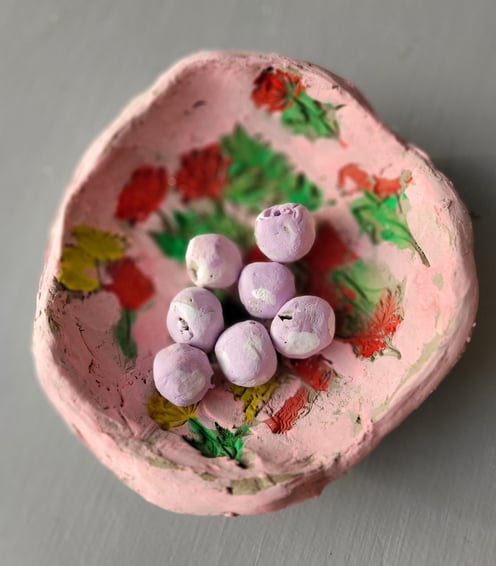
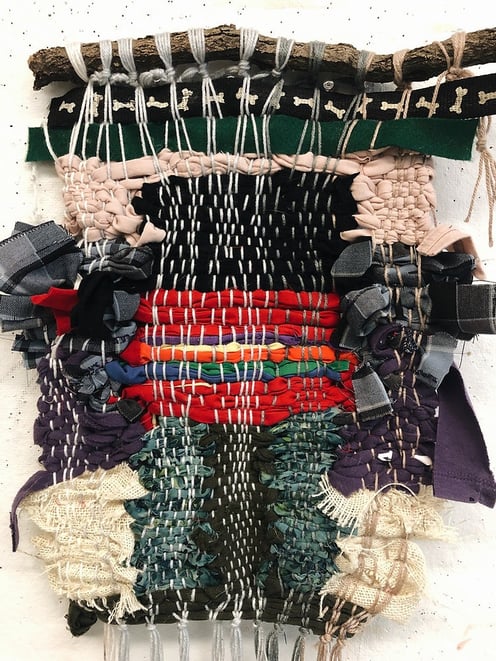



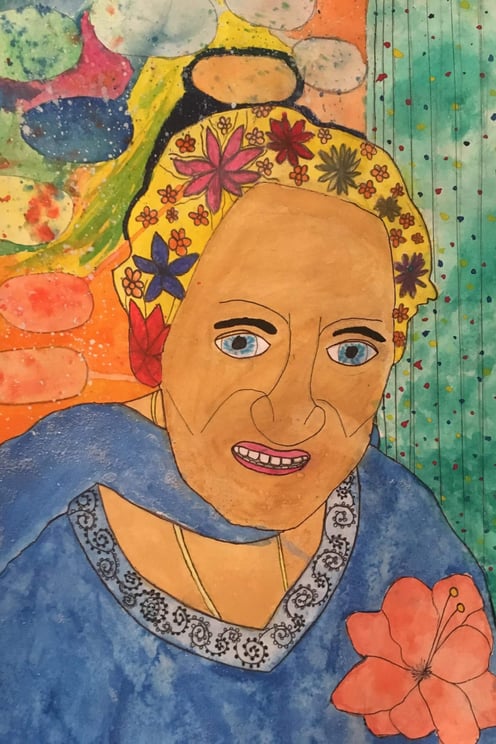
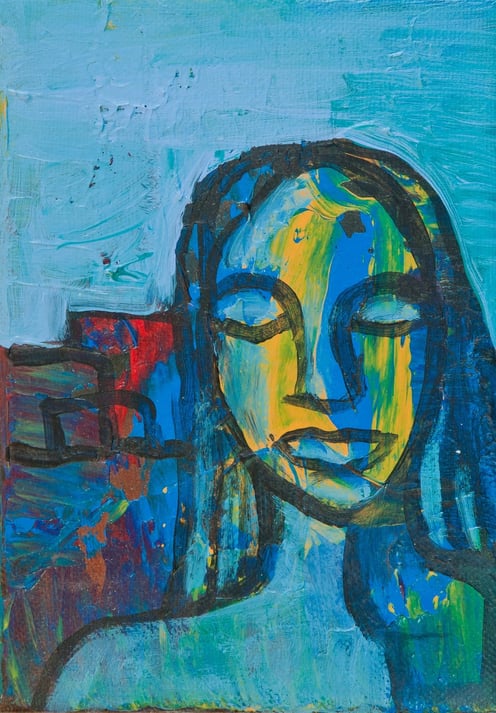









Personal Reflection
Life creates endless opportunities for change and transition. Change can renew feelings of possibility, excitement and joy. It can also evoke fear, nervousness and anticipation. How do we navigate these transitions in a safe way while stepping confidently forward towards the new?
We may want to hang on to what is known, even when part of us knows it no longer serves us.
We may miss the comfort and safety the ‘known’ brings.
We may miss the parts of ourselves that we identify as keeping us safe and necessary for our survival.
When we experience change and transition, there are supportive processes we can choose to work with to help us access our own strength and resources.
It may be that you have lost a loved one, ended a relationship, moved house, state or country. You are finishing employment, studies, or saying goodbye to patterns or coping strategies that no longer serve you. It may feel big or small, whatever it is, know, it is worthy of being seen, witnessed and supported.
Ritual is a powerful tool for honoring the process of change and transition. Below are some ritual suggestions. Your ritual process is unique to you so please adapt the suggestions below to include what feels right. The creative process is just that, a process, and the art making is not about what the art looks like at the end. Give yourself permission for it to be imperfectly perfect.
Support
You may like to invite someone close to you to support you in this process and witness the experience. Let them know what it is and what you might need throughout. It might be that you want them to just witness and listen, or you might like to ask for reflections from them or a cuddle. Let them know that you don’t need them to interpret it or solve anything, but just to be there with you. You can also do this by yourself.
Gather Symbols
This step is completely up to you, but I suggest that you find objects that represent what you are letting go of, and comforting objects that support you and nurture you, as well as objects that represent what you want to create more of in your life. These objects may be symbolic of the experiences you have had and that you want more of.
Prepare a Calm Space for Creative Exploration
Take a few moments to prepare a peaceful, nurturing space for yourself. You might begin by gently tidying the area and gathering any art supplies you’ll need. When you’re ready, light a candle or some incense to symbolize the start of this journey. If it feels soothing, put on some soft, relaxing music—acoustic, ambient, or nature-inspired sounds can help create a serene atmosphere. (If you’d like recommendations, consider exploring Yellow Brick Cinema on YouTube.) Let the gentle glow of the candle and the tranquil music guide you into a place of ease, inviting you to be fully present for this creative, healing session.
The Art of Limiting Beliefs
Benjamin Franklin once said, “You can do anything you set your mind to.” And as a celebrated polymath who boasted various accomplishments from founding father to inventor to printer to postmaster, he certainly lived according to that maxim. But despite the fact that he lived 200+ years ago, we hear this quote all the time even today—whether while growing up, throughout our careers, or in raising our own children as a source of encouragement and positive thinking.
What’s interesting though is we don’t always address the fact that the opposite is just as true: you can’t do anything you don’t set your mind to. Because the reality is what we believe in is incredibly powerful and shapes how we feel and see the world. However, our beliefs can also limit us in not only our thinking, but also our actions and ultimately, our lives. And this is where limiting beliefs come in.
What Are Limiting Beliefs?
In effect, limiting beliefs are thoughts, convictions, or opinions that we believe to be absolute truths that hold us back in some shape or form. As a result, they prevent us from growing, achieving our goals, taking risks or new opportunities, or becoming the people we want to be.
These beliefs can be about yourself (“I’m not an artistic person”), the world (“I can’t switch careers because people will judge me”), or life in general and how it works (“I should avoid confrontation at all costs”). In fact, the word “should” is a prime culprit when we are trying to identify limiting beliefs. But in the end, the result is generally the same: we’re kept in the same box our minds have unconsciously built.
Where Do Our Limiting Beliefs Come From?
As to be expected, most limiting beliefs are developed in our youth as we’re shaping who we are and how we view the world around us. So it follows that the specific origins of limiting beliefs can really vary from person to person. In general though, limiting beliefs typically stem from a few sources, including:
1. How you were raised as well as the beliefs your family instilled in you and how you interpreted those beliefs. This could cover a wide range of topics from whether you feel valued by others to what type of career path you should take to how you should behave in social settings.
2. Your education by not only your teachers and professors, but also by your family, friends, and peers. While growing up, you’re constantly learning and absorbing new information, ideas, and opinions about yourself as a person as well as how things work and this can shape your own conceptions of what you can and cannot do.
3. Your life experiences, especially any that end negatively, and the conclusions you draw from them. These experiences can create limiting beliefs as defense mechanisms to avoid adverse feelings in the future.
Business mindset coach Nina Cooke summed it up nicely in Forbes: “Many limiting beliefs are created in our childhood. Devastatingly, they become part of our identity… Mistakenly, we think these stories are keeping us safe, protecting us from rejection and humiliation. The reality is, they’re just stories we make up in our head by attaching made-up meanings to events. And they cost us dearly all our lives.”
Examples of Limiting Beliefs
So what are some examples of common limiting beliefs? By and large, limiting beliefs typically follow a framework of “I’m not…” or “I can’t…” or “I don’t…” or with the connotation that “This is how the world works…” As you can imagine, the possibilities when it comes to limiting beliefs can ironically enough be limitless.
As mentioned earlier, they can also cover a wide range of topics. You can have limiting beliefs about yourself and your capabilities or circumstances, about what other people will think or do based on your actions or what’s socially acceptable, or about life in general and how things work. Some examples you may have heard or even thought of yourself include:
“I am not worthy of being loved.”
“I am not smart/pretty/talented enough.”
“I could never open my own business.”
“I don’t have enough time/experience/resources to pursue my passion.”
“I should avoid failure at all costs.”
“I should never question authority.”
“I’m too old to go back to grad school.”
“No one will want to date me because I’m divorced.”
“It’s too late to adopt a healthier lifestyle.”
“All romantic relationships end in heartbreak.”
Overcoming Limiting Beliefs, Step by Step
Even though limiting beliefs can be difficult to discern because they are so ingrained in our mindsets and how we approach our day-to-day lives, the good news is it is possible to overcome them. However, like many things, doing so takes time and it’s important to respect the process and be patient.
In general, the key to overcoming limiting beliefs is reflection, self-awareness, and reframing. You need to not only identify your limiting beliefs and take responsibility for them, but also let them go and reframe them in order to move forward. Below is a step-by-step process on how to do just that. However, it’s important to note that overcoming limiting beliefs hardly has a one-size-fits-all methodology. For some people, this process will work well; for others, alternatives like therapy, meditation, or other forms of self-improvement may work best. In the end, only you know what works best for you!
1. Choose a Topic That You Want To Address
Due to the wide span of topics that limiting beliefs can involve, start with picking one that you want to address. For example, think about your career and what ideas you hold that may be preventing you from accomplishing your goals. Other topics can be your love life, friendships, family relationships, finances, health, hobbies, or general thoughts about life and the world.
Perhaps you feel like a confident business woman on the inside, but when it comes time to live into that identity on the outside, you struggle to overcome impostor syndrome. If this feels familiar, rest assured – you are not alone. The good news is, you can push past this – keep reading for how to do so.
2. Write Down Your Limiting Beliefs About That Topic
Once you pick your topic, write down all the relevant limiting beliefs that fall under it that you feel strongly about or affect you everyday. What has held you back in this part of your life? In this category, what have you used as excuses in the past? What patterns have you noticed that you tend to fall into? Take time to evaluate your past behavior when you acted negatively and where that may have originated from as well as recurring challenges you’ve faced and why that might be.
3. Consider How Your Limiting Beliefs Have Protected You
In a similar vein, ask yourself how a belief has protected or served you thus far in your life. Mark Manson, author of “The Subtle Art of Not Giving A F*ck,” explains it well here: “We like to imagine ourselves to be the victims of our own limiting beliefs, but the truth is that we adopt these beliefs because they serve us in some way… Generally, we hold onto limiting beliefs for the same reasons—to protect ourselves from struggle and failure. Also, we often hold onto limiting beliefs because they make us feel special, self-righteous or that we deserve special attention… Beliefs only stick if they serve us in some way, figure out how your belief is serving you and ask yourself if it’s really worth it or not.”
There are times when we hold onto our limiting beliefs because it feels safe, whereas getting outside our comfort zone means coming face-to-face with the scary and unknown. Be honest with yourself: how are your limiting beliefs serving you?
4. Reject Your Limiting Beliefs, Reframe Them, and Test Out The Alternatives
Once you’ve reflected on the context and reasoning behind a limiting belief, ask yourself, “What if I’m wrong? What if it’s not true?” Think about what that would mean and what your world would look like. Remember what limiting beliefs are at their core—they’re just thoughts or stories you’ve told yourself. That doesn’t necessarily make them true.
Then think about some alternatives to your limiting belief and reframe it into an empowering idea. For example, instead of thinking “It’s too late to adopt a healthier lifestyle,” change it to “I haven’t been living a healthy lifestyle, but I am willing to start now.”
However, the other half of the coin in taking back your power is being willing to test out those reframed beliefs in the real world. As Omar Itani puts it, “You will not be able to overcome your limiting beliefs if you don’t see real contradicting evidence in your behavior… While you are the one who creates your limiting beliefs, it is your behavior that solidifies them. Likewise, it is your behaviour that would debunk them.”
From: No More Limits: What Are Limiting Beliefs & How Can You Overcome Them?
Articles
Videos
Get Rid of Self-Limiting Beliefs (17 minutes)
How to change your limiting beliefs for more success | Dr. Irum Tahir (12 minutes)
How To Overcome Psychological Barriers (11 minutes)
Continue Your Learning
Art Supplies
Mixed media paper
Writing paper or a notebook
Pen or pencil
Crayons, coloured pencils, markers, or paints
Creative Activity
Directions
This activity blends Cognitive Behavioural Therapy (CBT) with art therapy, inviting you to explore and visualize how your automatic negative thoughts affect your emotions.
Step 1: Create a Thought Record
Take a few minutes to complete a Thought Record. Here’s how to do it:
Recall a Time: Think of a time when you experienced a strong limiting belief. Write down the details of the situation: Who were you with? What were you doing? When did it happen? Where were you?
Identify Your Feelings: Describe each feeling you had during that time in one word. Rate the intensity of each feeling from 0% to 100% (how strong did you feel it?). Circle the feeling you want to explore further.
Automatic Thoughts and Images: Write down the automatic thoughts and images that come to mind when you think about this limiting belief. Answer these questions for the feeling you circled:
- What was going through my mind just before I started to feel this way?
- What images or memories do I have in this situation?
Step 2: Draw Your Limiting Belief
Create an image that represents how you feel when you hold onto the limiting belief you identified in Step 1. Focus on what it feels like to let this belief grab hold of your attention and dominate your thinking. Use colours, shapes, and symbols to convey the emotional intensity of this experience.
Step 3: Generate Alternative Thoughts
Write down some alternative and balanced thoughts in response to your limiting belief. For example, you may have a limiting belief around money, such as, “I don’t have enough money to enjoy my life.” Alternative and balanced thoughts could be: "I have the power to create meaningful experiences with the resources I have." "My worth and ability to enjoy life are not determined by my financial status." "I can find joy in connecting with others and building relationships, which doesn’t require much money." If you're unsure what to write, imagine you’re talking to a close friend who has this limiting belief. What kind and supportive advice would you give them?
Step 4: Draw Your New Balanced Thought
Create a new drawing that shows how you feel when you embrace these alternative and balanced thoughts. Let this image reflect the positive emotional shift you experience as the new thought(s) becomes part of your awareness.
After you finish your artwork, grab a pen and notebook and write down your answers to the following questions:
1) What emotions or thoughts did I notice coming up as I created the first drawing?
2) How does this image reflect the intensity and nature of my limiting belief?
3) How did it feel to come up with alternative or balanced thoughts?
4) Which alternative thoughts resonate with me the most and why?
5) What emotions or shifts did I notice while creating the second drawing?
6) How does this image capture the positive change or new perspective I have gained?
7) What does this new drawing reveal about how I feel when I embrace balanced thoughts?
8) How might this new perspective impact my feelings and actions in the future?
Set an Intention
Before you begin, I invite you to close your eyes and take a few deep breaths. Let yourself be here right now in this moment. Turn your attention inwards, place your palms face down on the paper in front of you, and set an intention for this creative exercise. You may choose to say aloud or silently in your heart, "May this creative journey guide me in transforming my negative thoughts into a source of balance and peace, allowing me to see my inner strength and embrace the power of change." Take a moment to give the paper gratitude for holding space for you today.
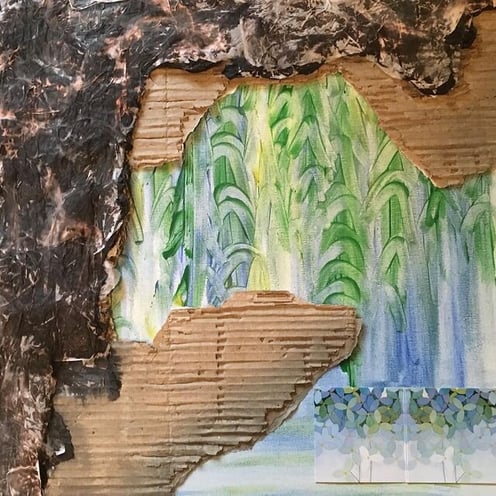
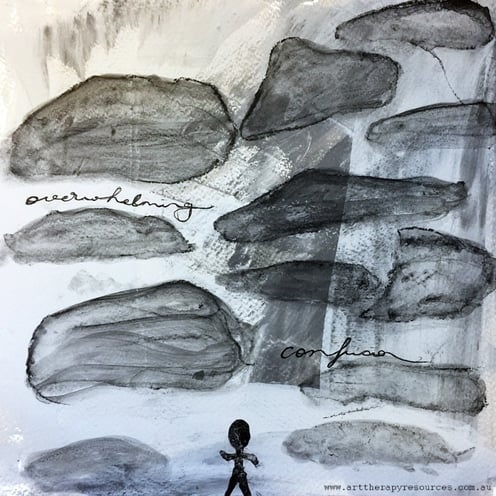
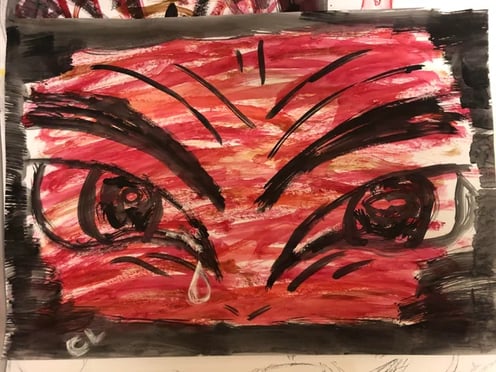

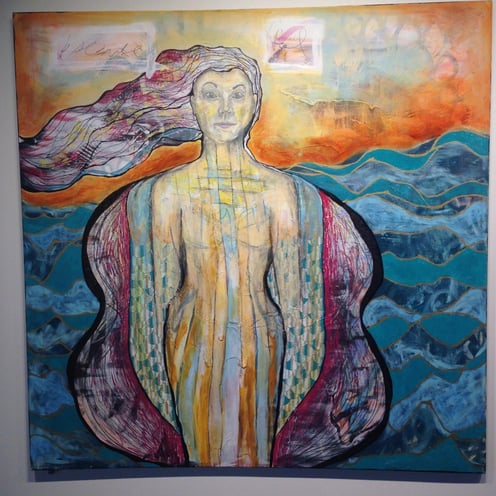
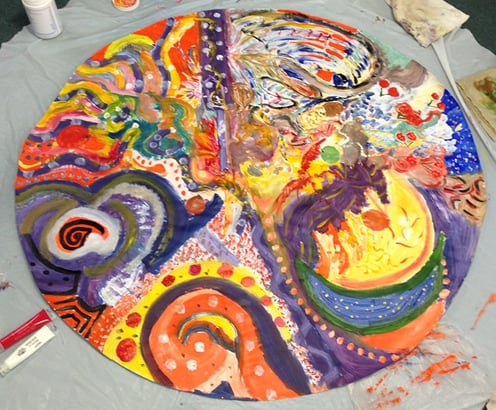
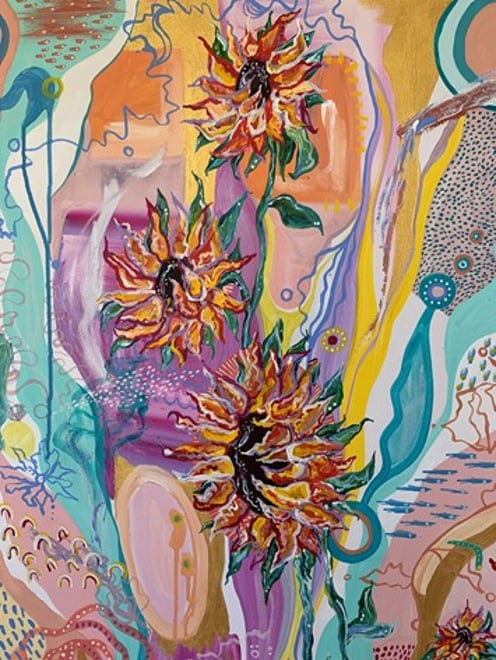







Personal Reflection
Prepare a Calm Space for Creative Exploration
Take a few moments to prepare a peaceful, nurturing space for yourself. You might begin by gently tidying the area and gathering any art supplies you’ll need. When you’re ready, light a candle or some incense to symbolize the start of this journey. If it feels soothing, put on some soft, relaxing music—acoustic, ambient, or nature-inspired sounds can help create a serene atmosphere. (If you’d like recommendations, consider exploring Yellow Brick Cinema on YouTube.) Let the gentle glow of the candle and the tranquil music guide you into a place of ease, inviting you to be fully present for this creative, healing session.
